Chess Notes
Edward Winter
When contacting us by e-mail, correspondents are asked to include their name and full postal address and, when providing information, to quote exact book and magazine sources. The word ‘chess’ needs to appear in the subject-line or in the message itself.
| First column | << previous | Archives [179] | next >> | Current column |
11340. Correspondence between Capablanca and Bonar Law
Permission for us to reproduce an exchange of letters between Capablanca and Andrew Bonar Law has been obtained by Olimpiu G. Urcan (Singapore) from the UK Parliament Parliamentary Archives:
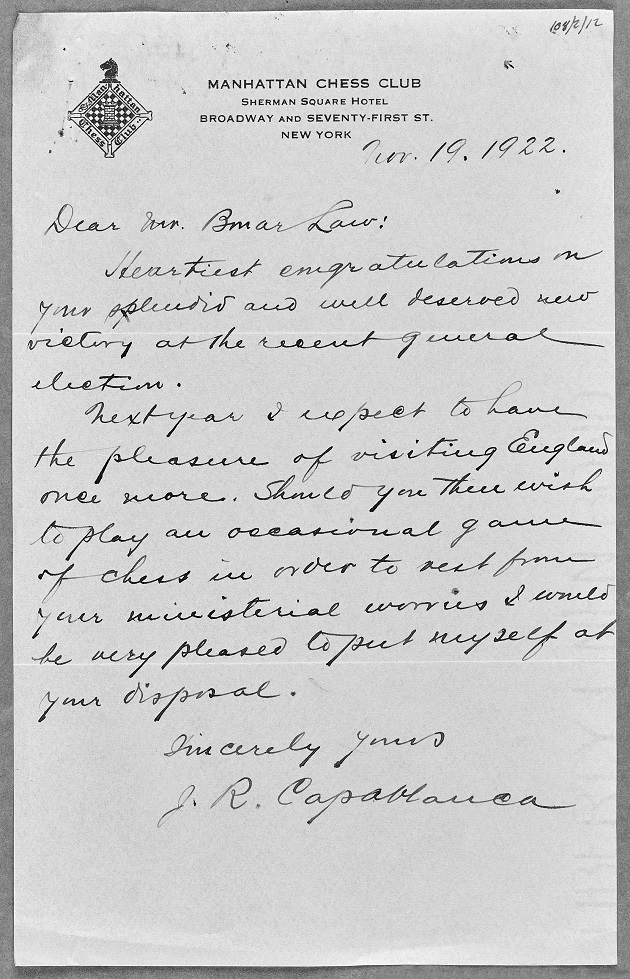

11341. The Club Argentino de Ajedrez (C.N. 11330)
A second set of pictures submitted by Carlos León Cranbourne (Buenos Aires):
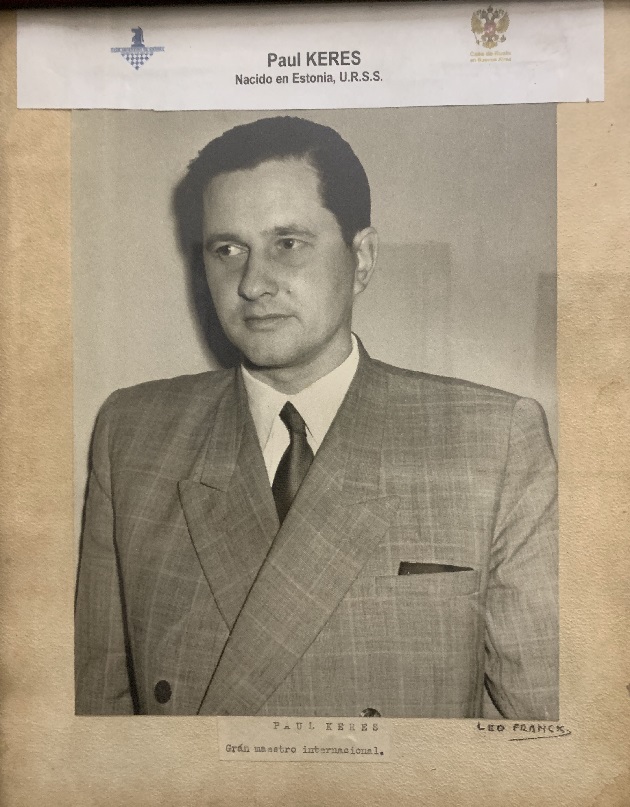


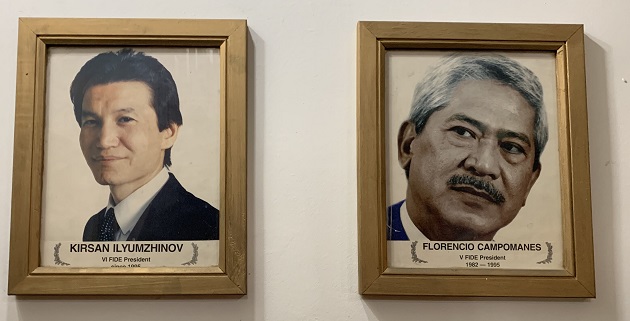
11342. Frank Marshall consultation game
In the item below, from page 7 of the January 1932 American Chess Bulletin, a comment by Marshall about 1 Nf3 is worth noting:
‘This is recognized as the latest and strongest in hyper-modern openings and is an extremely difficult move to answer.’

1 Nf3 Nf6 2 c4 b6 3 g3 Bb7 4 Bg2 e6 5 Nc3 c5 6 d3 Be7 7 O-O O-O 8 Bf4 d6 9 e4 e5 10 Bg5 Nc6 11 Bxf6 Bxf6 12 Nd5 g6 13 a3 Bg7 14 b4
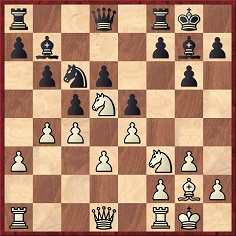
14...f5 15 Rb1 fxe4 16 dxe4 Bc8 17 Nh4 Nd4 18 Qd3 Bg4 19 f3 Be6 20 Bh1 Qd7 21 Ng2 Rf7 22 Rf2 Raf8 23 Rbf1 Bxd5 24 exd5 cxb4 25 axb4 Qa4 26 b5 e4 27 fxe4 Rxf2 28 Rxf2 Qa1+ 29 Rf1 Rxf1+ 30 Qxf1 Nf3+ 31 Kf2 Bd4+ 32 Ne3 Bxe3+ 33 White resigns.
The notes after (q) have yet to be found.
11343. H. du Bourblanc (C.N.s 8017 & 8029)
John Townsend (Wokingham, England) writes:
‘Du Bourblanc’s will, signed “Hyppolite du Bourblanc”, was written on 10 May 1813 in London (London Metropolitan Archives, DL/C/0454/078/001-003). It is in French, but the accompanying papers include an English translation, which is the source for the following summary.
The testator ordered all his possessions to be sold and divided into three equal shares, for the benefit of:
1. his father and, afterwards, his two sisters in England, Alexandrine and Antoinette;
2. his mother and, afterwards, his two sisters married in France, Adèle de Derval and Amélie de France;
3. his brother and, afterwards, his children.
His father and brother were appointed executors.
Probate was granted on 23 June 1814 to his brother, Count Saturnin François Alexandre du Bourblanc, of 36 Upper Norton Street, Marylebone, the value sworn to be under £300. The deceased was referred to as being of Upper Norton Street, Marylebone, esquire, and it was noted that he “died in September last” (i.e. 1813).’
11344. Spelling
‘Labourdonnais’, ‘De La Bourdonnais’ and many variants exist in chess literature, and Ulvi Bajarani (Baku) asks whether a preferred spelling can be determined.
C.N. 5149 showed an image from Worlds of Chess Champions, a booklet issued by the Cleveland Public Library in October 2003:
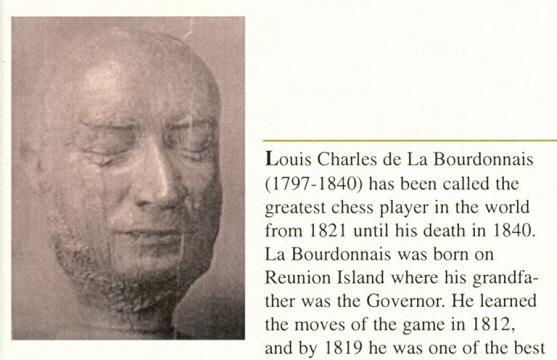
The present item leaves aside his forenames (Louis Charles Mahé can be found in various combinations) to focus on the surname. First, his signature on an 1838 letter shown in C.N.s 7379 and 7383:


Next, his magazine, Le Palamède:

The introduction to the first issue had, on pages 6-7, ‘M. de la Bourdonnais’. An announcement on page 35 was signed ‘DE LA BOURDONNAIS’. Pages 428-429 had ‘M. de La Bourdonnais’ a number of times. Page 15 of the first 1842 volume of Le Palamède referred to ‘M. Mahé de Labourdonnais’, but ‘Labourdonnais’ appeared increasingly in the magazine.
Tolerance of several spellings thus seems advisable, but what about simply ‘Bourdonnais’? At the conclusion of a review of The Oxford Companion to Chess by David Hooper and Kenneth Whyld (Oxford, 1984), G.H. Diggle, the Badmaster, wrote in the December 1984 Newsflash:
‘The BM has left his one “grouse” till last – the eminent German master von der Lasa is always referred to as plain “Lasa”; worse still, the great La Bourdonnais appears throughout as “Bourdonnais”. To a diehard Tory like the BM, this “La-lopping” and cutting down the timber of the aristocracy has a nasty egalitarian look.’
The book review was reproduced on pages 12-13 of volume two of Chess Characters by G.H. Diggle (Geneva, 1987).
11345. A composition by Keres (C.N. 11335)
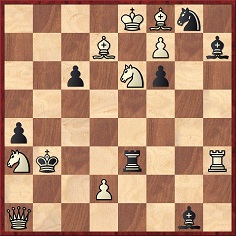
Mate in two
Henry Tanner (Helsinki) notes that this problem is not in Schackvärlden, 1934, although the Swedish magazine had other compositions by Keres around the same time.
The earliest appearance of the above-mentioned incorrect source that our correspondent has found is on pages 60-61 of Chess Problems: Introduction to an Art by Michael Lipton, R.C.O. Matthews and John M. Rice (London, 1963):
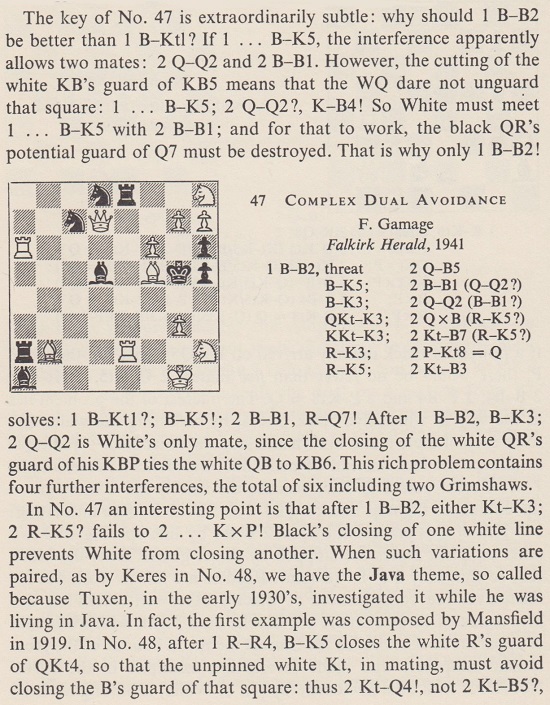
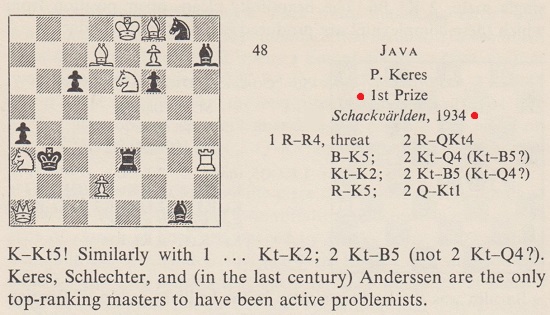
11346. Chess play and problems
An observation by C.H.O’D. Alexander in his Foreword to the book mentioned in the previous item (page 5):
‘The player comes to problems with the advantage of knowing thoroughly the language of chess, but with the disadvantage of being accustomed to a quite different use of this language. It is as if having read books solely for the sake of the information contained, one started to read poetry – entirely different things are now significant.’
11347. Frank Marshall consultation game (C.N. 11342)
Patsy A. D’Eramo (North East, MD, USA) has found Marshall’s complete notes on page 10 of the Allentown Morning Call, 29 November 1931:

We can add that the Sun column referred to was on page 40 of the 20 November 1931 edition:

11348. Napoleon Bonaparte
‘Chess is too much of a game to be a science and too much of a science to be a game’ is a remark sometimes ascribed, with variants, to Montaigne, Gottfried Leibniz and ‘Mendelssohn’, and it has been discussed in C.N.s 3574, 3676, 4133, 4378 and 8824.
Olimpiu G. Urcan has noted this version:
‘I abstain from chess – it’s too amusing to be fair work, and too hard work to be amusing.’
As readily verifiable on Google Books, those words were written by Thomas Henry Huxley in a letter dated 1 November 1866 to Alfred Russel Wallace.
An item about Napoleon Bonaparte on page 7 of King, Queen and Knight by N. Knight and W. Guy (London, 1975):

The text attributed to Napoleon in a 1961 Swedish translation of a book by Jerzy Giżycki (not ‘Gizyeki’) is, verbatim, what appears on page 213 of the 1972 English edition, entitled A History of Chess:

It is unclear why Knight and Guy referred to the Swedish edition, Stora Schackboken (Cracow, 1961), but, for the record, below is the relevant passage, from page 222:

The original Polish book, Z szachami przez wieki i kraje, had been published in Warsaw in 1960 (and not 1961, as stated by Knight and Guy). An extract from page 184:
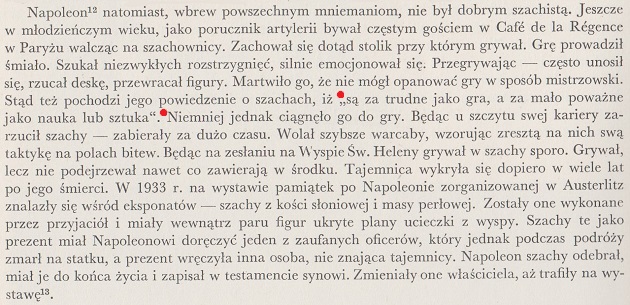
The corresponding endnotes on page 322:
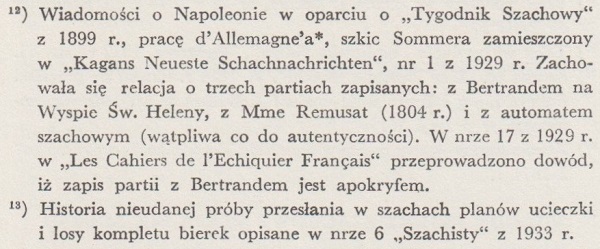
What are the exact grounds for attributing any such remark to Napoleon Bonaparte?
11349. The Club Argentino de Ajedrez (C.N.s 11330 & 11341)
Carlos León Cranbourne (Buenos Aires) has provided a third set of photographs, relating to Capablanca and Alekhine and including their 1927 world title match: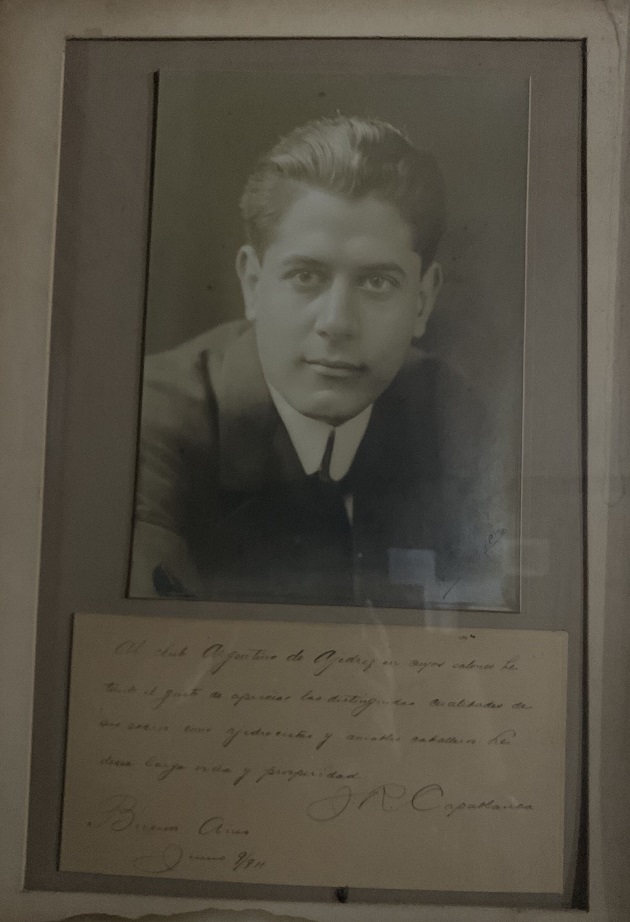



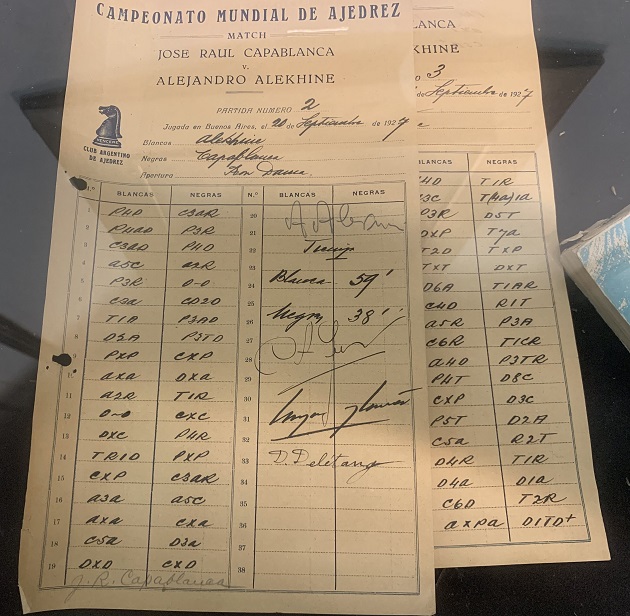


11350. The Sibyl
Jerry Spinrad (Nashville, TN, USA) asks for information about a planned monthly magazine entitled The Sibyl. This announcement was on page 150 of The Era, 23 December 1838:
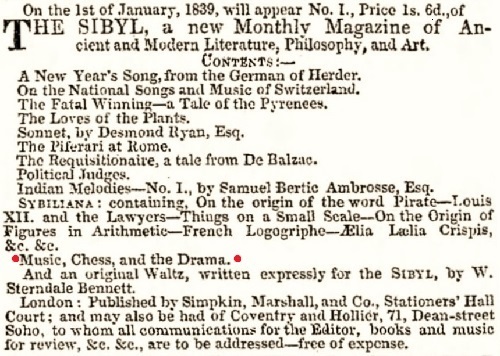
Similar advertisements, each with a reference to chess, were published in The Era of 13 January 1839 (page 191 – ‘On the 1st of February, 1839, will appear No. I ...’), 3 February 1839 (page 227 – ‘March the 1st, will appear No. I ...’), 17 February 1839 (page 231 – ‘March the 1st, will appear No. I ...’), 3 March 1839 (page 275), 10 March 1839 (page 287) and 17 March (page 299). The last three advertisements had no planned publication date:

Who was due to provide the chess content for The Sibyl?
11351. An article by Tartakower
Zdenĕk Závodný (Brno, Czech Republic) has forwarded an article by Tartakower, ‘Die Welt des Schachspielers. Eine historisch-psychologische Studie’, on pages 15-17 of the 6/1920 edition of Moderne Welt:
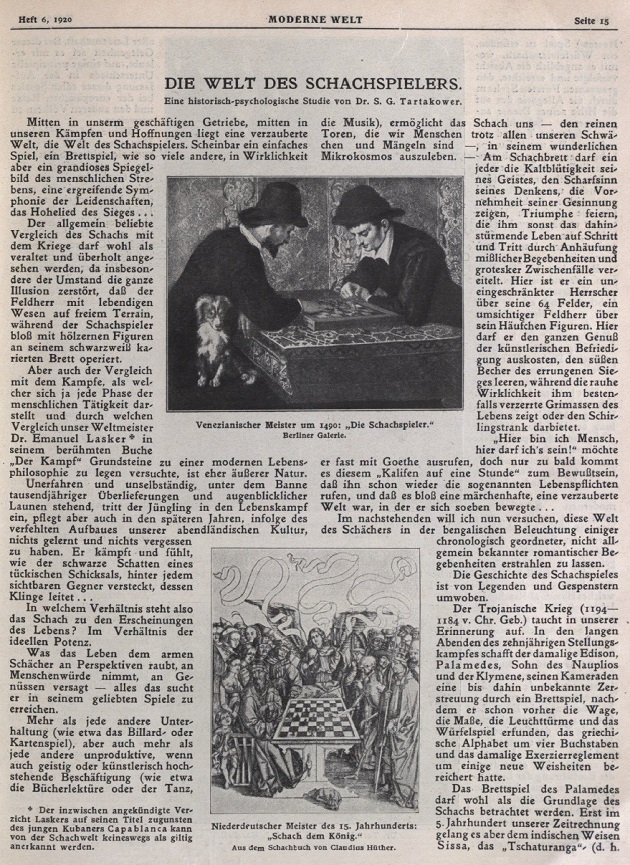
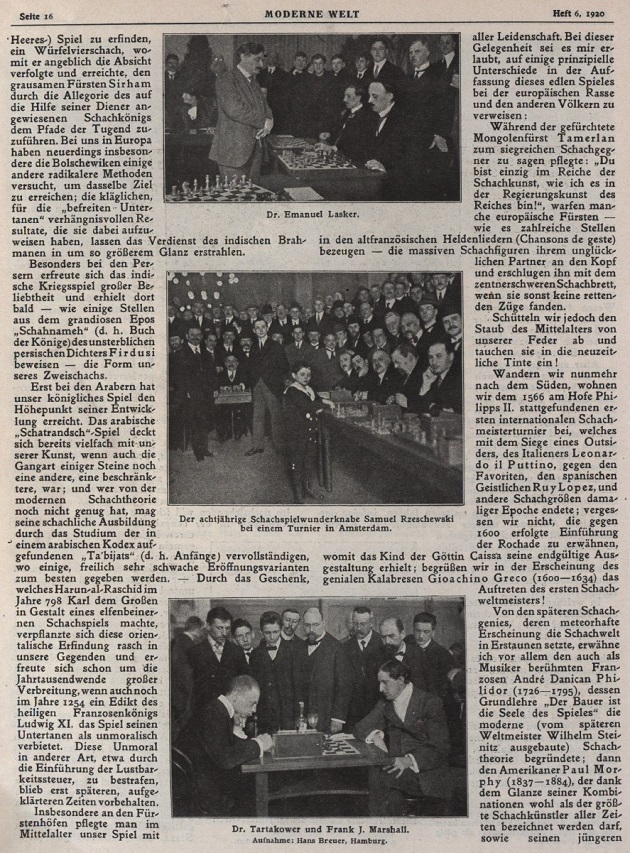

Tartakower reproduced the article, without the pictures, on pages 3-7 of his booklet Am Baum der Schacherkenntnis (Berlin, 1921).
11352. Old age
From page 189 of The Golden Treasury of Chess by Francis J. Wellmuth (Philadelphia and New York, 1943):
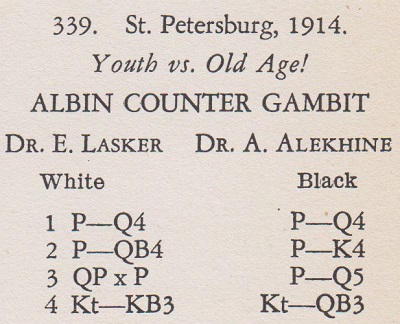
Lasker was aged 45.
The ‘Youth vs. Old Age!’ heading remained in Al Horowitz’s editions of the Treasury (game 190).
The annotations by Fred Reinfeld to Schlechter’s win over Alekhine at Carlsbad, 1911 concluded on page 120 of The Unknown Alekhine 1905-1914 (London and New York, 1949) with this remark:
‘For once, old age conquered youth.’
As pointed out in C.N. 643 (see page 147 of Chess Explorations), Schlechter was 37.
11353. G.H. Diggle
An example of G.H. Diggle’s writing skill is his ‘Retrospect’ article on pages 34-36 of the January 1955 BCM. The first two paragraphs:
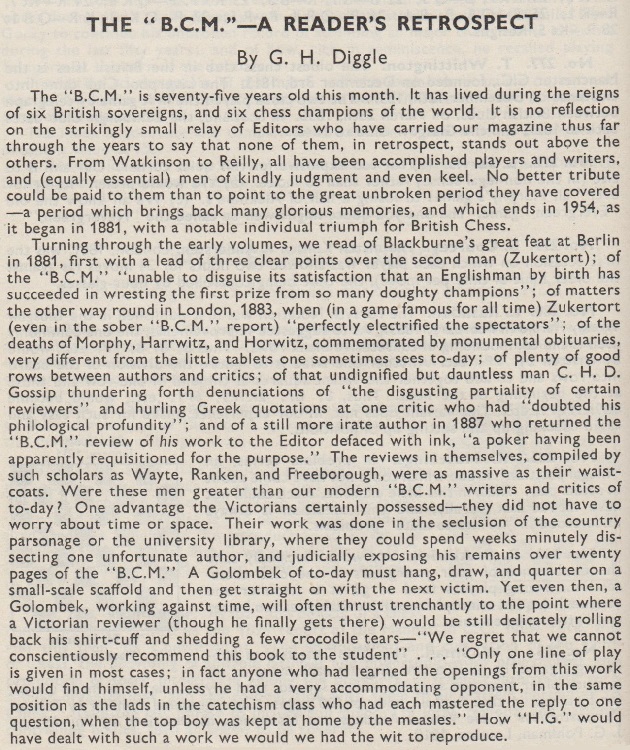
The ‘still more irate author’ (in 1885, not 1887) was Thomas B. Rowland, who had co-authored Chess Fruits with Frideswide F. Rowland. Following publication of the first part of an anonymous review on pages 147-149 of the April 1885 BCM he wrote in to denounce ‘the most extraordinary and injurious article you have published under the heading of a Review. The writer was evidently mad or drunk’.
Among the magazine’s comments in reply:
‘By the same post came back our April number with the pages containing the review defaced with ink, the end of a poker having apparently been “requisitioned” for the purpose.’
Source: BCM, May 1885, pages 191-192.
11354. Rubinstein at Budapest, 1926
A rare interview with Akiba Rubinstein, from page 2 of Die Stunde, 4 July 1926:

Rubinstein’s game against Colle, a 30-move draw, was played on 29 June 1926, as shown on page 30 of the Lachaga tournament book.
11355. Alekhine v Bogoljubow (C.N.s 5667, 5697, 6312 & 7724)
C.N. 5667 referred to this photograph on page 191 of Grandmasters of Chess by Harold C. Schonberg (Philadelphia and New York, 1972), mentioning that the man behind the players remains nameless:
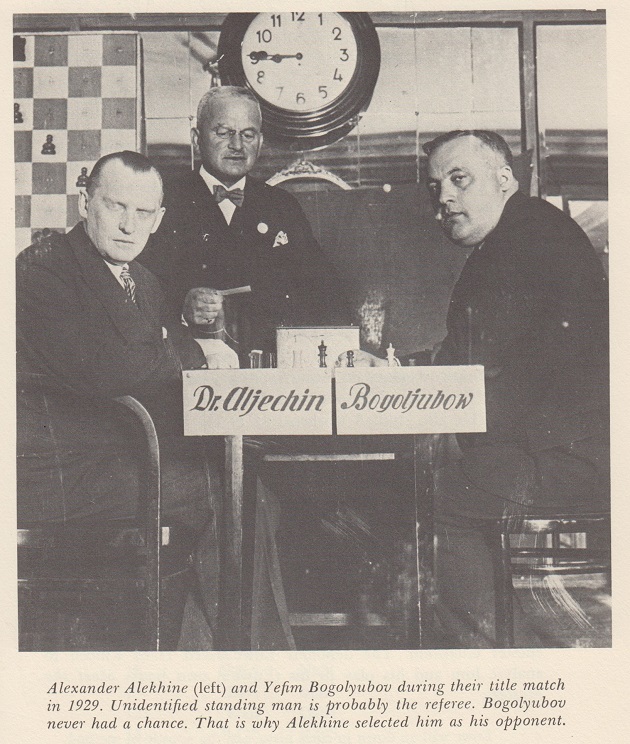
Page 8 credited the picture to Burt Hochberg. Although Alekhine’s eyes seem closed, it may be a matter of photographic exposure, given the following on page 79 of Umkämpfte Krone by Raymund Stolze (East Berlin, 1986):
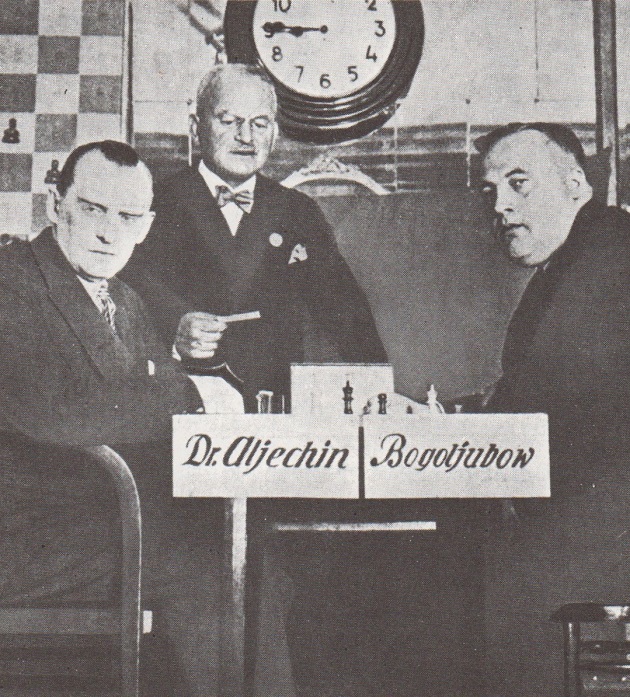
Can the position on the board and/or on the demonstration board be identified?
11356. Qh6
Eduardo Bauzá Mercére (New York, NY, USA) has sent three forgotten games with a common theme:
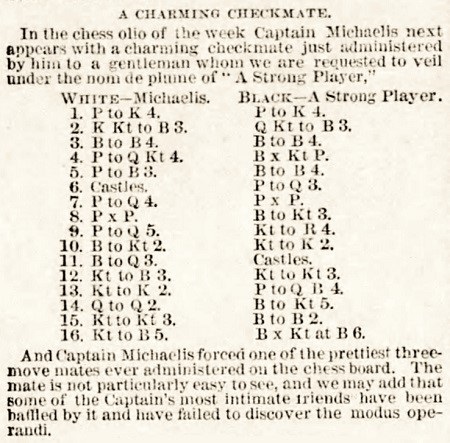
Philadelphia Times, 15 October 1882, page 8
Michaelis v N.N.: 1 e4 e5 2 Nf3 Nc6 3 Bc4 Bc5 4 b4 Bxb4 5 c3 Bc5 6 O-O d6 7 d4 exd4 8 cxd4 Bb6 9 d5 Na5 10 Bb2 Ne7 11 Bd3 O-O 12 Nc3 Ng6 13 Ne2 c5 14 Qd2 Bg4 15 Ng3 Bc7 16 Nf5 Bxf3

White gave mate in three moves.

New Orleans Times-Democrat, 18 December 1892, page 19
Orchard v Harris: 1 e4 e5 2 Nf3 Nc6 3 Bc4 Bc5 4 b4 Bxb4 5 c3 Ba5 6 d4 exd4 7 O-O dxc3 8 Qb3 Qf6 9 e5 Qg6 10 Nxc3 Nge7 11 Ba3 Rb8 12 Ne2 b5 13 Bd3 Qe6 14 Qb1 b4 15 Bb2 Ng6 16 Ned4 Nxd4 17 Nxd4 Qb6 18 Nf5 O-O 19 Qc1 c5 20 e6 dxe6
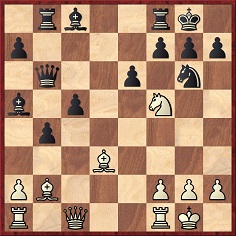
21 Qh6 and mate next move.

Reading Observer, 1 April 1911, page 7
Walcker v Patchoffsky: 1 e4 e5 2 Nf3 Nf6 3 Nxe5 d6 4 Nf3 Nxe4 5 Nc3 Nxc3 6 dxc3 Be7 7 Be3 Nd7 8 Bd3 O-O 9 O-O Nf6 10 h3 Be6 11 Nd4 Bd5 12 Nf5 Qd7 13 c4 Bc6 14 Qd2 Rae8 15 Bd4 Be4 16 Bxe4 Nxe4
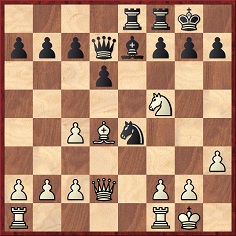
17 Qh6 Resigns.
We add that the last game was published on pages 79-80 of the March 1911 Deutsche Schachzeitung with a precise date, a Russian source and different spellings/transliterations of the players’ names (Walker v Paschkowski):
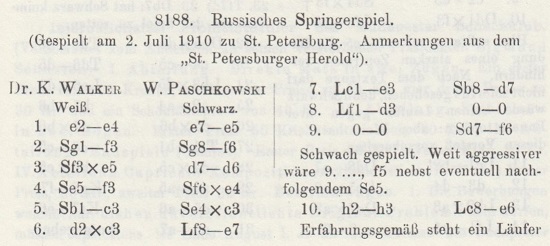
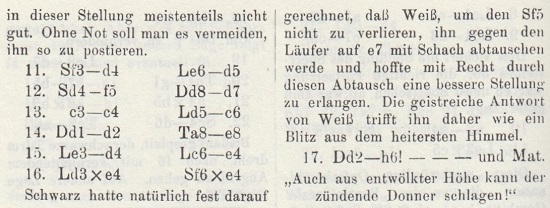
The Qh6 motif is discussed in chapter 18 of L’art de faire mat/The Art of the Checkmate by Georges Renaud and Victor Kahn (various editions).
11357. When was the Immortal Game played?
The Immortal Game feature article shows that according to page 221 of La Régence, July 1851 the Anderssen v Kieseritzky brilliancy was played in London on 21 June 1851. Now, though, Fabrizio Zavatarelli (Milan, Italy) draws attention to this passage on page 482 of volume two of the Baltische Schachblätter:
‘Die unsterbliche Partie. Diese wurde zwischen Anderssen und Kieseritzky in London am 13. (25.) Mai 1851 gespielt.’
A related footnote on the same page added:
‘Diese genauere und richtigere Datumangabe beruht darauf, dass die Partie im St. George-Club am Tage vor der Eröffnung des grossen Londoner Schachturniers gespielt wurde.’
Mr Zavatarelli comments that the writer, F. Amelung, had detailed knowledge of Kieseritzky, having published an article about him on pages 55-87 of the first volume of Baltische Schachblätter (1890) which included 16 letters, or excerpts therefrom, written by Kieseritzky.
Play in the London tournament began on Tuesday, 27 May 1851, the pairings having been made the previous day (Deutsche Schachzeitung, May, 1851, pages 163-164).
Our correspondent adds that Anderssen wrote an account of his journey to London (a letter dated 1 June 1851) on pages 165-169 of the June-July 1851 Deutsche Schachzeitung. It began:
‘Donnerstag, den 22. Mai, als eben der Morgen grauete, traf ich auf dem Dampfboot, das mich nach England übersetzte, mit Mayet zusammen ...’
Anderssen’s only mention of 25 May, at the bottom of page 167, carried the implication that, being Sunday, it was a day of rest:
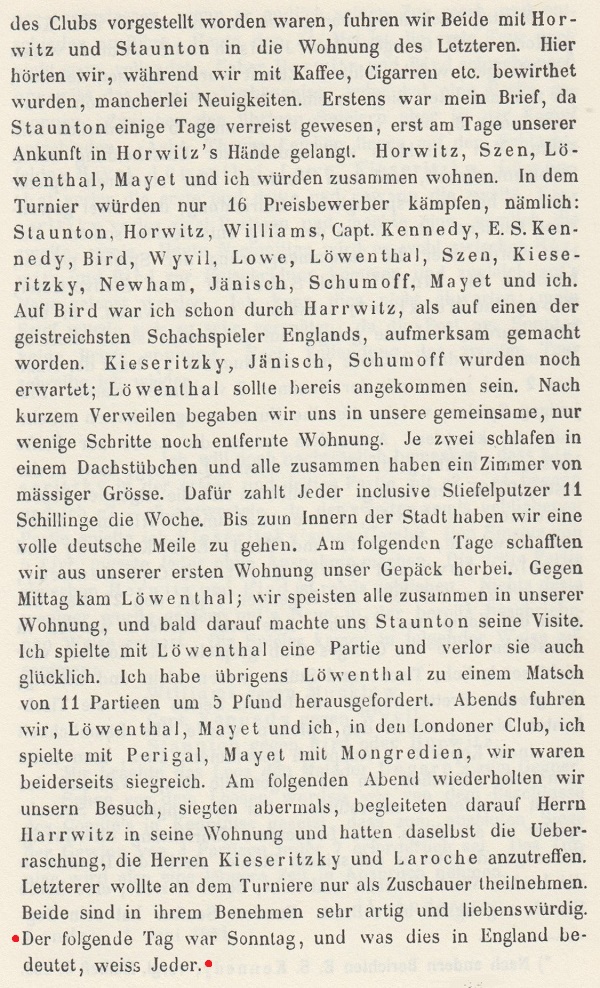
11358. Prince Gedroiz/Gedroits (C.N.s 10196, 10201 & 11336)
Yuri Kireev (Moscow) provides page 22 of the 2/1914 edition of Столица и усадьба. The article by E.A. Znosko-Borovsky features Prince Gedroiz/Gedroits:

Mr Kireev comments that the cartoon includes Capablanca even though he was not a participant in the event concerned, the All-Russian Tournament in St Petersburg (won jointly by Alekhine and Nimzowitsch).
11359. Alekhine v Bogoljubow (C.N.s 5667, 5697, 6312, 7724 & 11355)
On the basis of a more generously cropped version, Alan McGowan (Waterloo, Canada) points out that the photograph under discussion shows the 12th match-game, played in Berlin on 11-12 October 1929:

The pawn chain is white.
11360. Collusion (C.N. 4634)
An excerpt from an article by Al Horowitz, ‘Legislating Morals’, on page 6 of Chess Review, January 1948:

C.N. 4634 quoted the passage from its appearance on pages 20-21 of the anthology The Best In Chess by I.A. Horowitz and J.S. Battell (New York, 1965).
When Max Euwe discussed the finish of this well-known game (Santasiere v Kashdan, Boston, 1938) in his ‘End Game of the Month’ column on pages 104-106 of the April 1955 Chess Review, his concluding paragraph also had the ‘talked himself out of first prize’ remark:
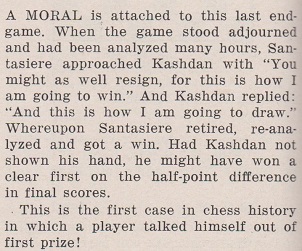
A highlight was the position after 125...Bh3-f1:
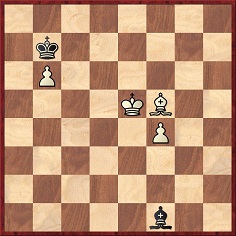
The article by Euwe gave Santasiere’s reply two exclamation marks.
11361. Alekhine and cats (C.N.s 4794, 5575, 8301, 9778 & 10054)
From page 11 of Het Noorden in woord en beeld, 19 November 1937:
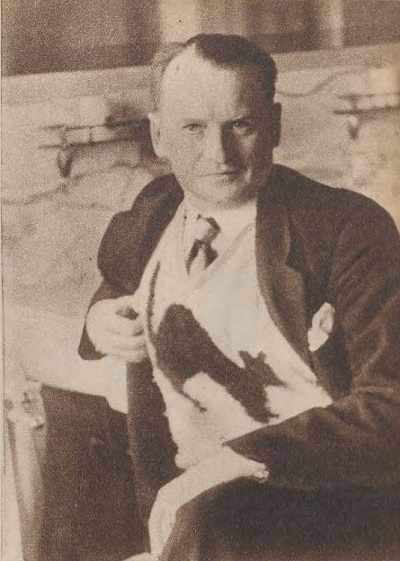
The full article:
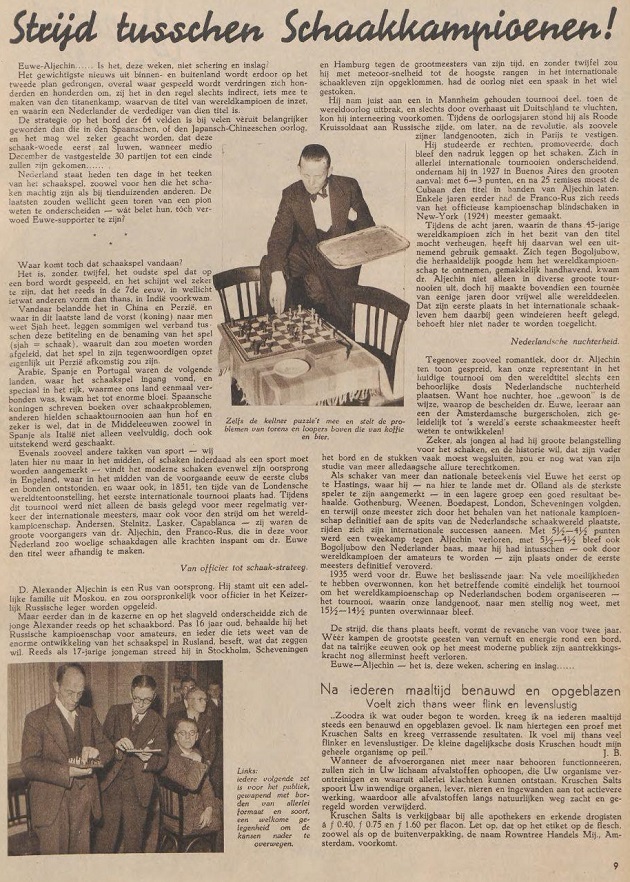
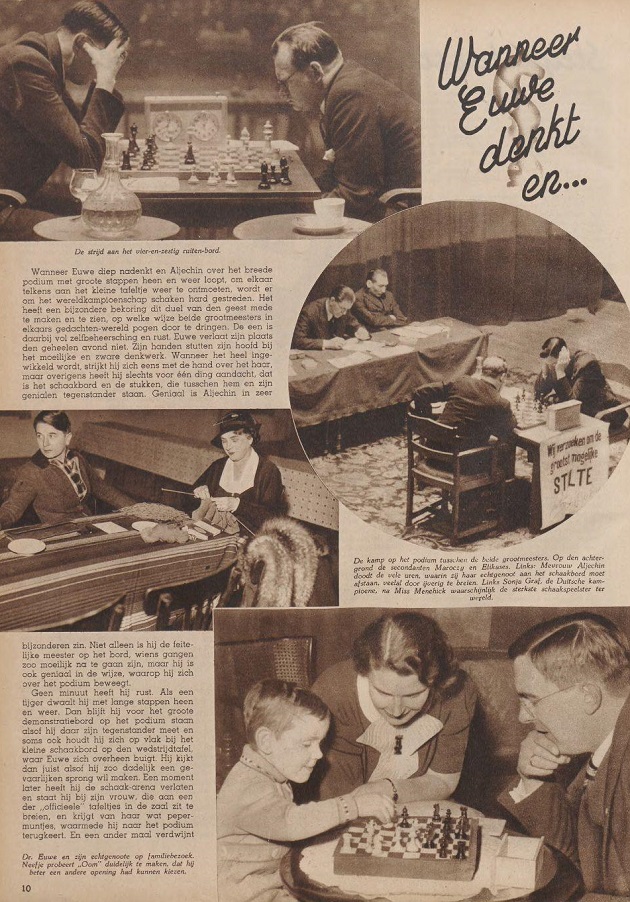
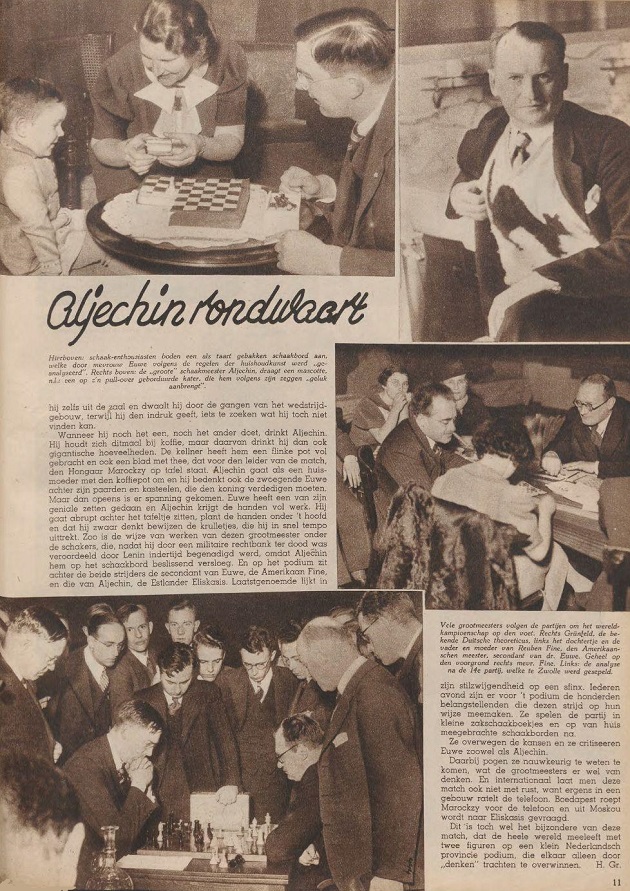
From page 15 of Sport in beeld, 13 December 1937:
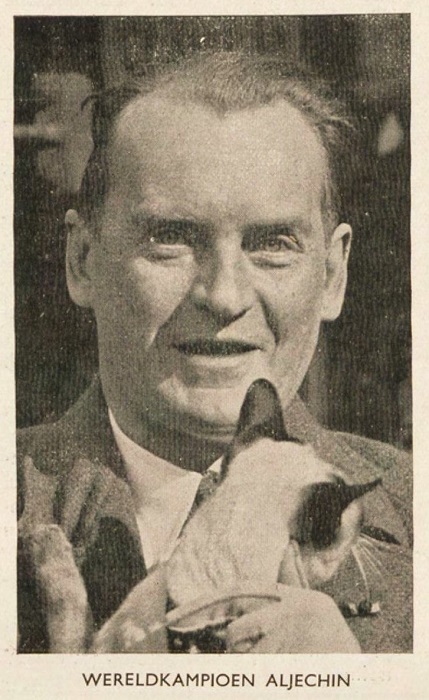
11362. Erling Tholfsen v Leo Edward
From page 26 of the Brooklyn Daily Eagle, 17 December 1931:
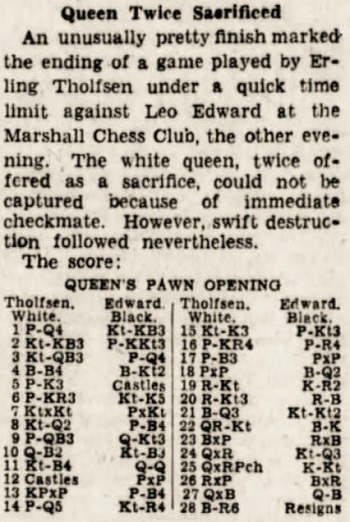
1 d4 Nf6 2 Nf3 g6 3 Nc3 d5 4 Bf4 Bg7 5 e3 O-O 6 h3 Ne4 7 Nxe4 dxe4 8 Nd2 c5 9 c3 Qb6 10 Qc2 Nc6 11 Nc4 Qd8 12 O-O-O cxd4 13 exd4 f5 14 d5 Na5 15 Ne3 b6 16 h4 h5 17 f3 exf3 18 gxf3 Bd7 19 Rg1 Kh7 20 Rg3 Rc8 21 Bd3 Nb7 22 Rdg1 Be8 23 Bxf5 Rxf5 24 Qxf5 Nd6 25 Qxh5+ Kg8 26 Rxg6 Bxg6 27 Qxg6 Qf8 28 Bh6 Resigns.
11363. Emanuel Lasker and draughts/checkers (C.N. 11314)
Yuri Kireev and Mikhail Sokolov (Moscow) have submitted two games. The first, from pages 127-128 of the 4/1897 Shakhmatny Zhurnal, was played in Moscow on 21 November 1896 (old style). Lasker’s opponent was P. Bobrov, and the notes were by V.I. Shoshin:
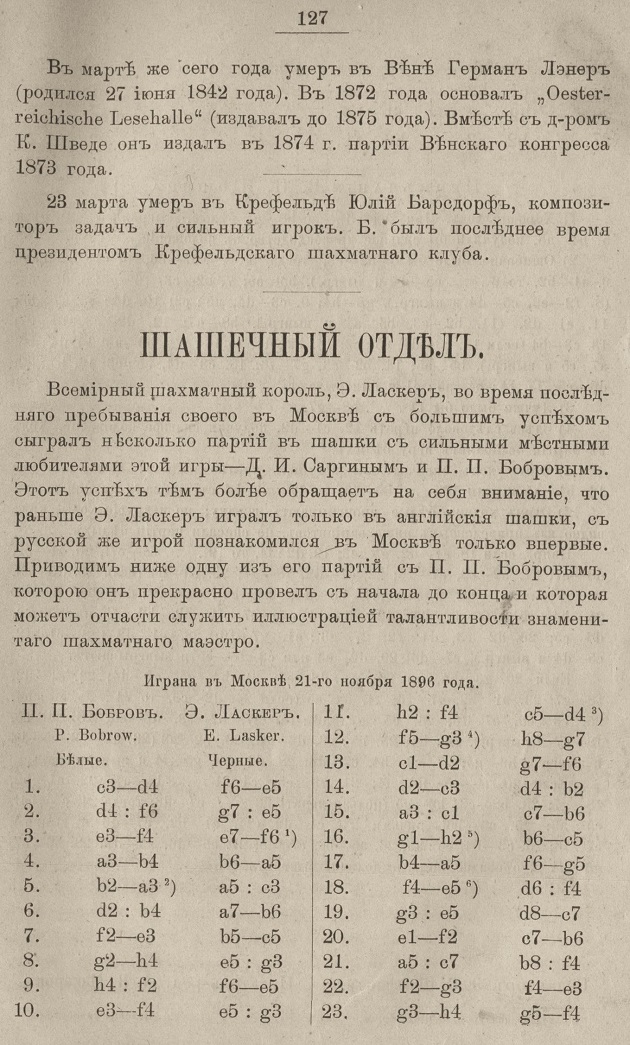
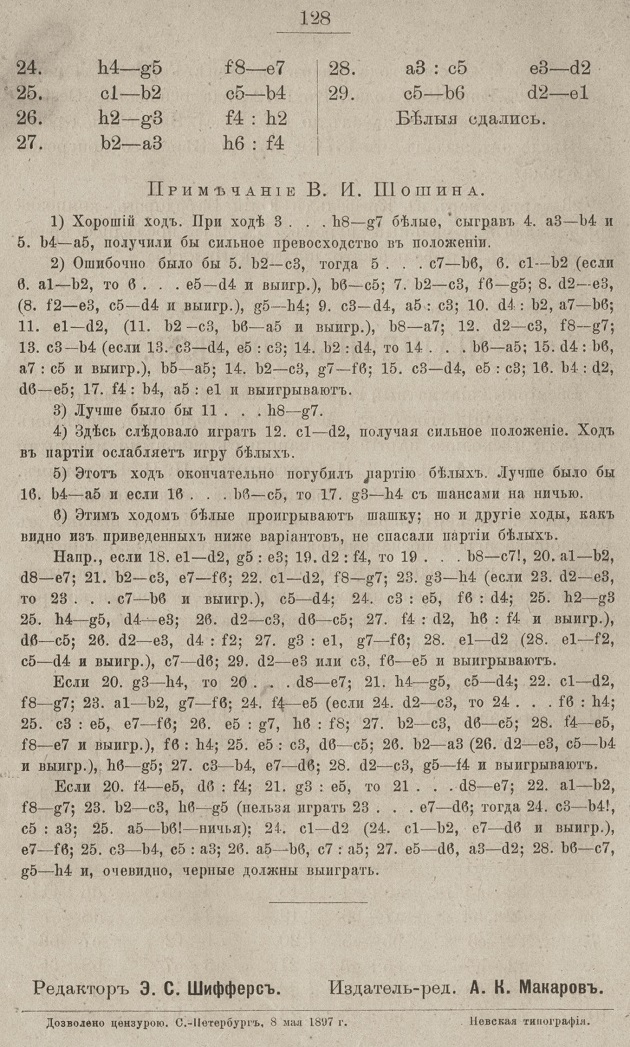
In the second game, from pages 194-195 of the 5-6/1897 Shakhmatny Zhurnal, Lasker faced Shoshin, who again supplied the notes. The game was played in St Petersburg on 17 January 1897 (old style):
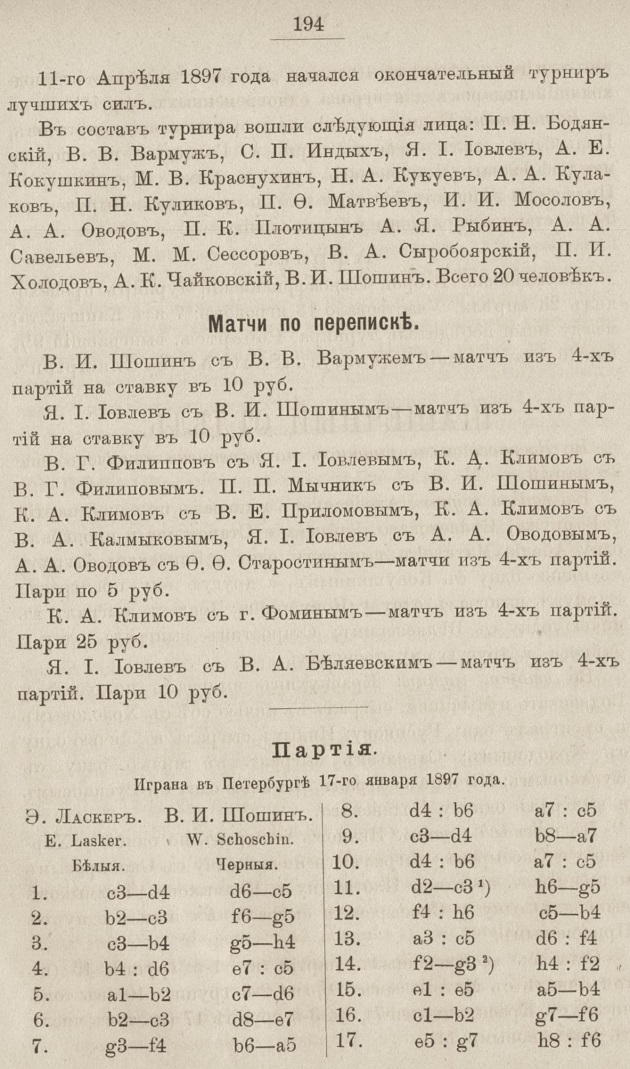
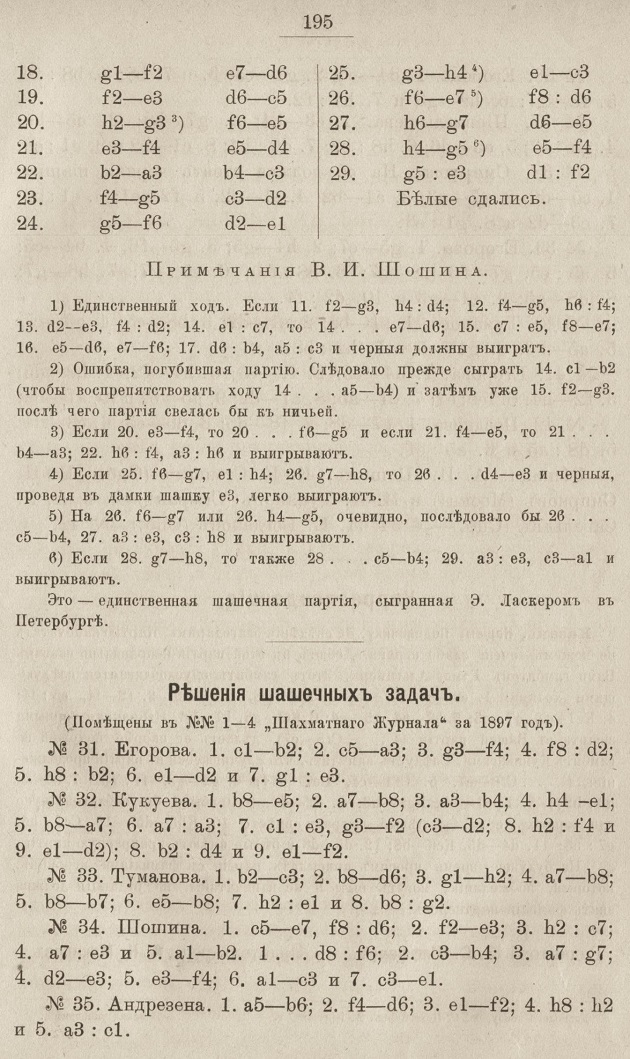
11364. The Immortal Game (C.N. 11357)
Concerning the date and venue of the Immortal Game, John Townsend (Wokingham, England) writes:
‘In C.N. 11357 Anderssen was quoted as indicating that Sunday was a day of rest in England. Gliddon’s (42 King Street, Covent Garden, London) was open for chess on Sundays according to an article by Alphonse Delannoy in Le Palamède, December 1845, page 559:
“Le second (Clydon [sic] Coffee House, Covent-Garden) jouit d’un privilège bien rare en Angleterre, celui de laisser jouer le dimanche.
C’est là que se rendent alors tous les amateurs que n’effraie pas l’excommunication anglaise ...”
Delannoy added that London players, including members of St George’s Chess Club, had a weekly gathering at Gliddon’s on Sundays:
“Au Clydon Coffee House se confondent alors les membres du Cavendish Square, du Grand Cigar’s Divan et du London’s Chess Club. Là se déroulent les événemens de la semaine, là s’enregistrent les bulletins de victoires et les tristes défaites. L’aristocratie du Cavendish Square descend à la familiarité du London’s Chess Club, et cette réunion ne manque pas d’intérêt.”
However, it seems improbable that Gliddon’s was the venue for the Immortal Game, and not least because Anderssen’s report mentioned no visit there. If the game was indeed played on 25 May, it cannot be excluded that the venue was one of the players’ lodgings.
The Baltische Schachblätter footnote cited in C.N. 11357 stated that the game was played at the St George’s Chess Club the day before the opening of the London tournament. Play in that event began on Tuesday, 27 May, and page lxiii of Staunton’s tournament book reported:
“The 26th of May, 1851, was the day appointed by the Committee of Management for the assemblage of all those who proposed to take part in the general mêlée. The appointment was punctually observed by most of the foreign players whom we had expected to be present at the Congress.”
Anderssen and Kieseritzky were required to attend at St George’s Chess Club on that day, when the “balloting for opponents” took place (page lxiv of the tournament book). Whether or not there was time for a few casual games has not been ascertained. As chance would have it, Anderssen and Kieseritzky were paired together for the first round.
Since the footnote cited in C.N. 11357 could mean that the date was 26, and not 25, May and since it also identifies the venue as the St George’s Chess Club, there are grounds for deducing that the Immortal Game was, in fact, played on Monday, 26 May, notwithstanding the dates (25 May and 21 June) given, respectively, in the Baltische Schachblätter and La Régence.’
We add below Anderssen’s account of the proceedings on Monday, 26 May from page 168 of the June-July 1851 Deutsche Schachzeitung:
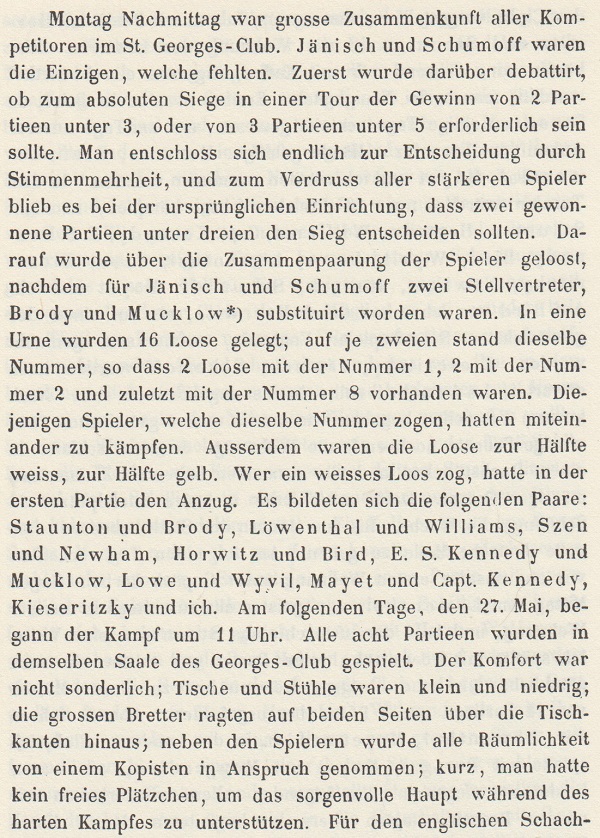
What corroboration exists of the common assertion that the Immortal Game was played at Simpson’s Divan?
Another question is when, and by whom, the Anderssen v Kieseritzky brilliancy was first named ‘the Immortal Game’. The entry on page 192 of the Dictionnaire des échecs by François Le Lionnais and Ernst Maget (Paris, 1967) named Philipp Hirschfeld (and incorrectly stated that Kieseritzky did not take part in the London, 1851 tournament):
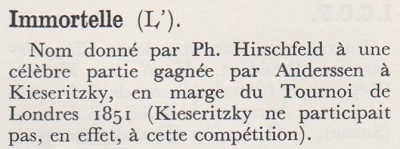
Page 277 of the Dizionario enciclopedico degli scacchi by Adriano Chicco and Giorgio Porreca (Milan, 1971) asserted that Falkbeer was the first to use the ‘Immortal’ name:

Regarding that reference to Falkbeer, below is an unsigned article on pages 293-297 of the August 1855 issue of his Wiener Schach-Zeitung:
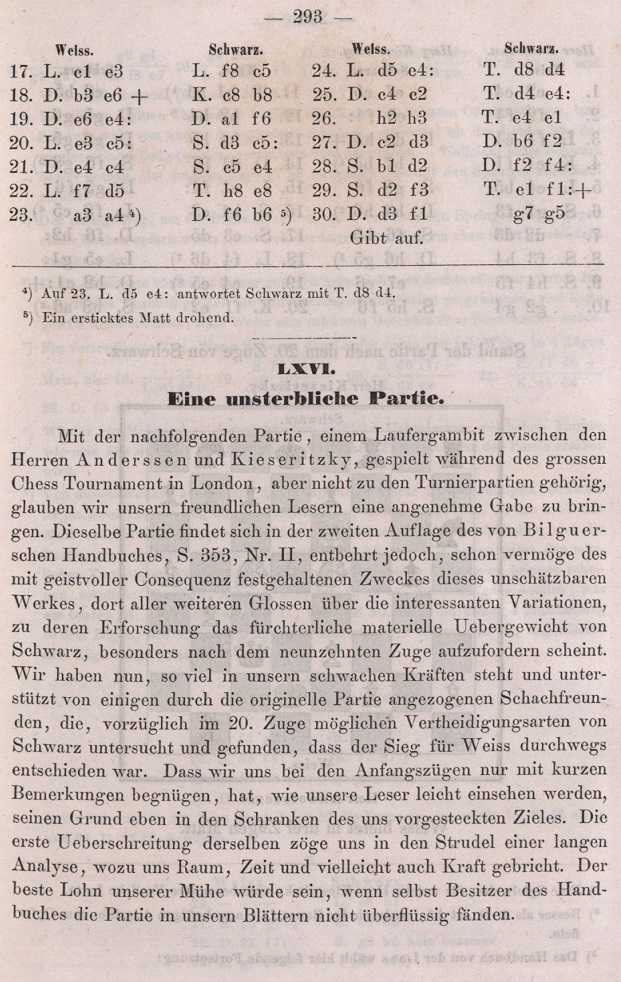

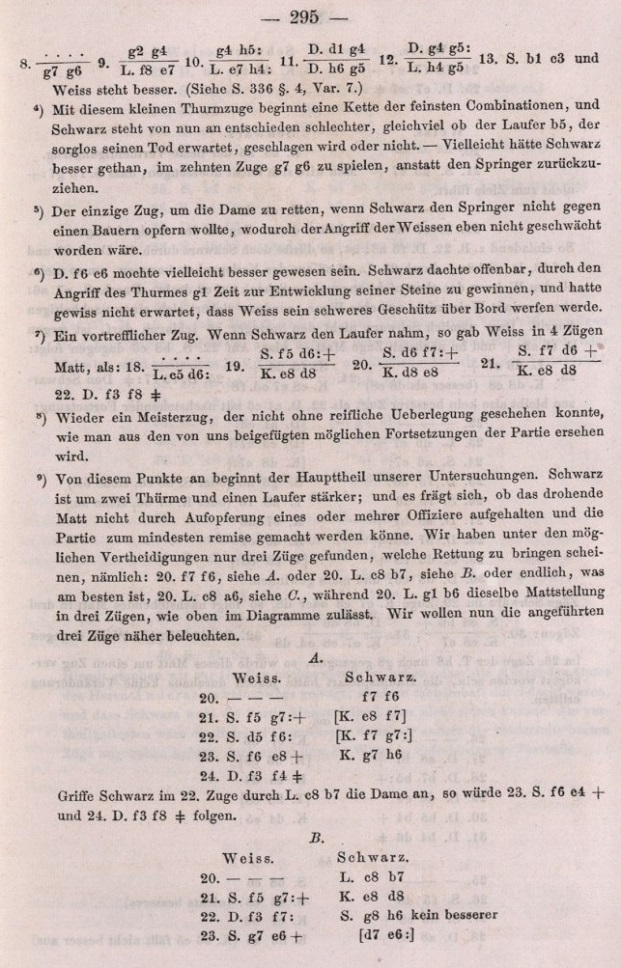
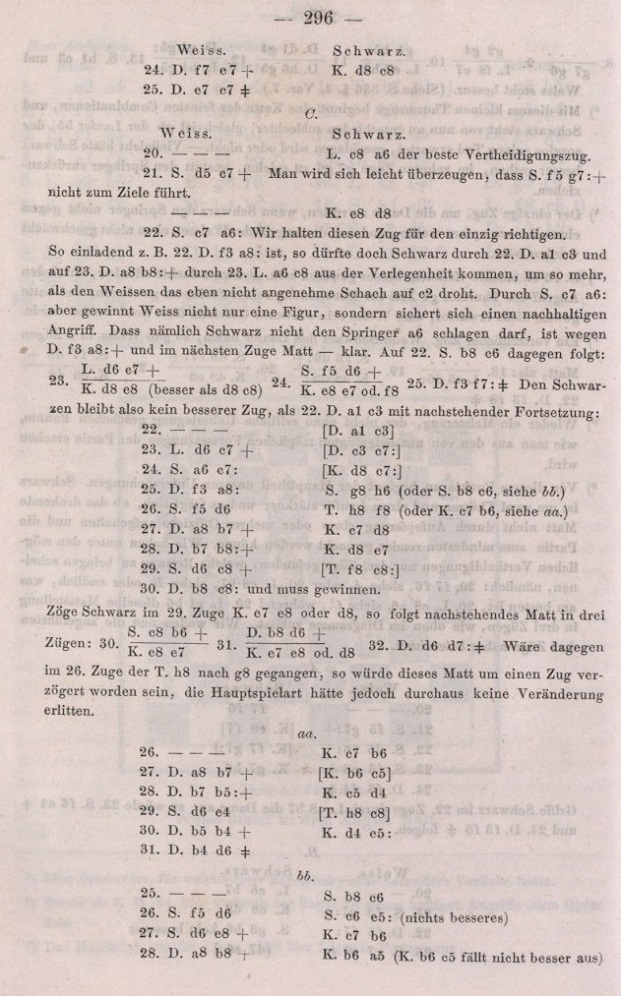
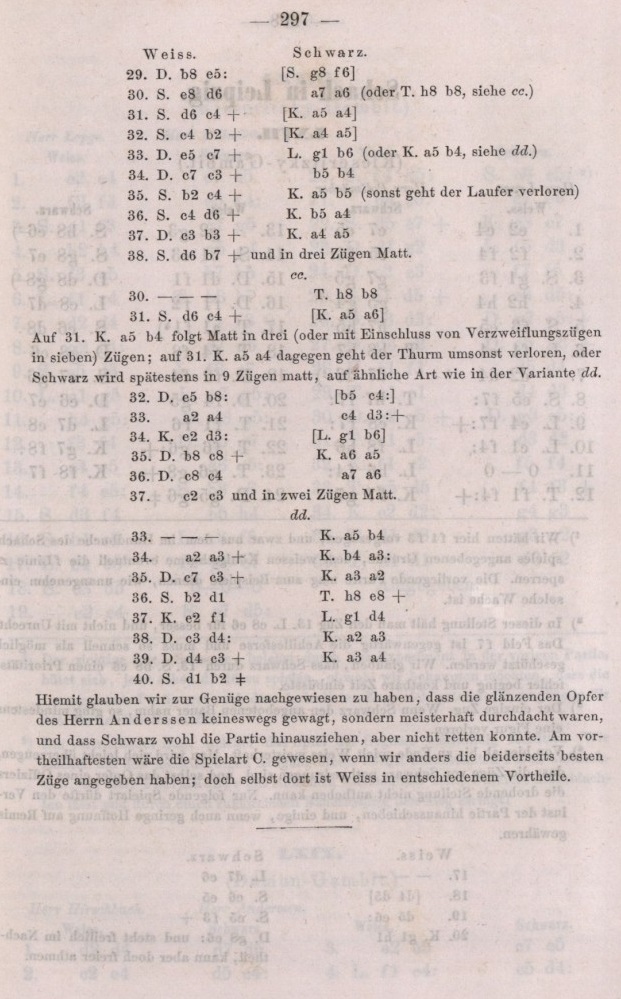
11365. Ostend, 1907
From page 253 of the August-September 1907 Wiener Schachzeitung:
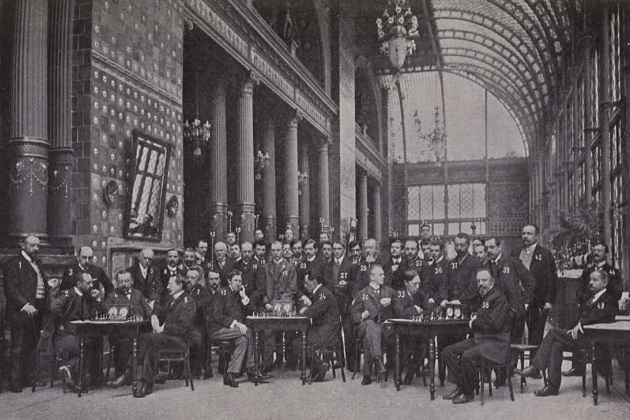
The next page had this key:

A high-quality version of the group photograph is on page 119 of De revue der sporten, 13 July 1907, accompanying an article by G.C.A. Oskam:
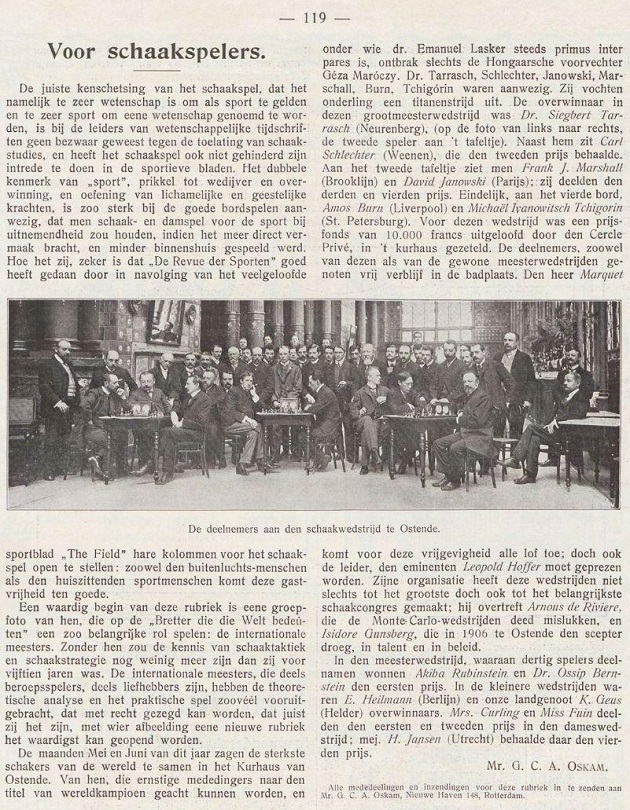
Large version of the photograph
A sample detail shows Amos Burn and Mikhail Chigorin:
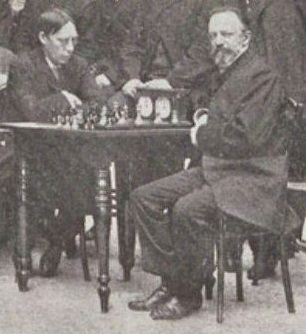
11366. David James Thouless
William Singleton (London) draws attention to a paragraph in the obituary of the physicist David James Thouless in The Times, 13 June 2019:
‘In 1954, while Thouless was reading natural sciences at Trinity Hall, Cambridge, the Soviet chess grandmaster David Bronstein played simultaneous matches against 25 members of the university chess club, winning 19 and drawing five. He was beaten, though, by Thouless.’
Bronstein’s score was +23 –1 =1 according to page 48 of the February 1954 BCM:

The display was on Saturday, 16 January 1954, and the same result, contradicting the version in The Times, was reported on page 89 of CHESS, March 1954. Neither magazine mentioned Thouless.
11367. Chess as a game or science (C.N. 11348)
An anonymous version of the quote under discussion was published on page 1 of the first issue of the Wiener Schach-Zeitung, January 1855:
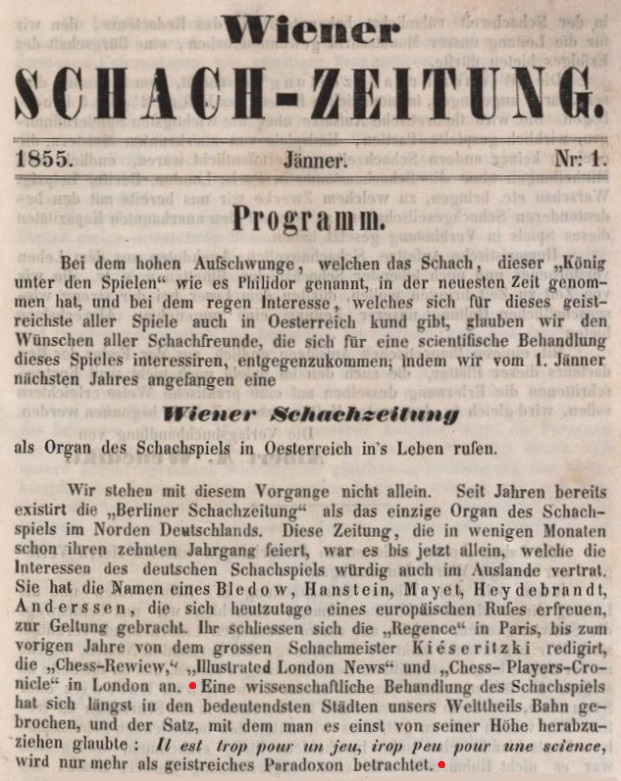
11368. An article by Juan Corzo
Yandy Rojas Barrios (Cárdenas, Cuba) has provided an article by Juan Corzo y Príncipe, written after Emanuel Lasker announced his resignation as world champion, on pages 47 and 76 of Social, July 1920:
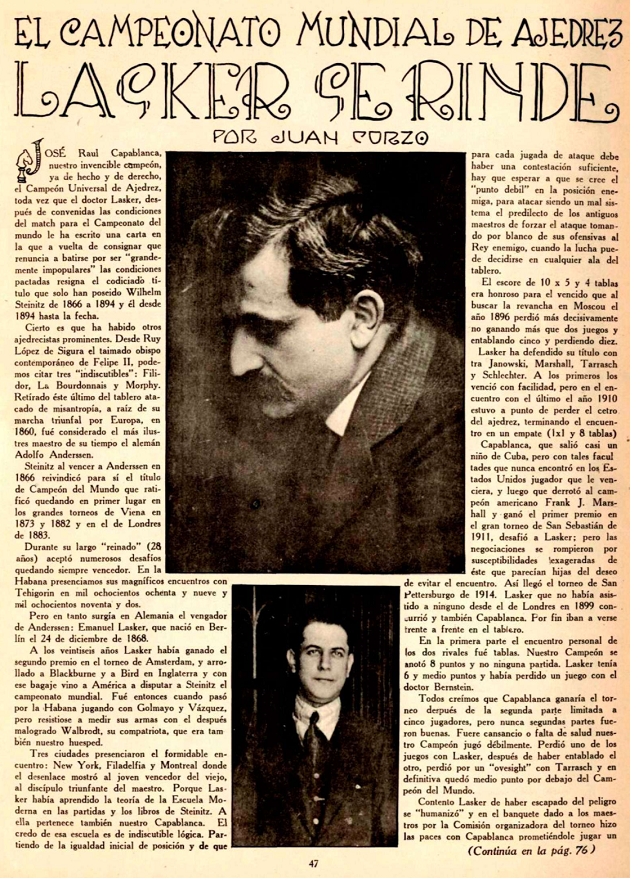
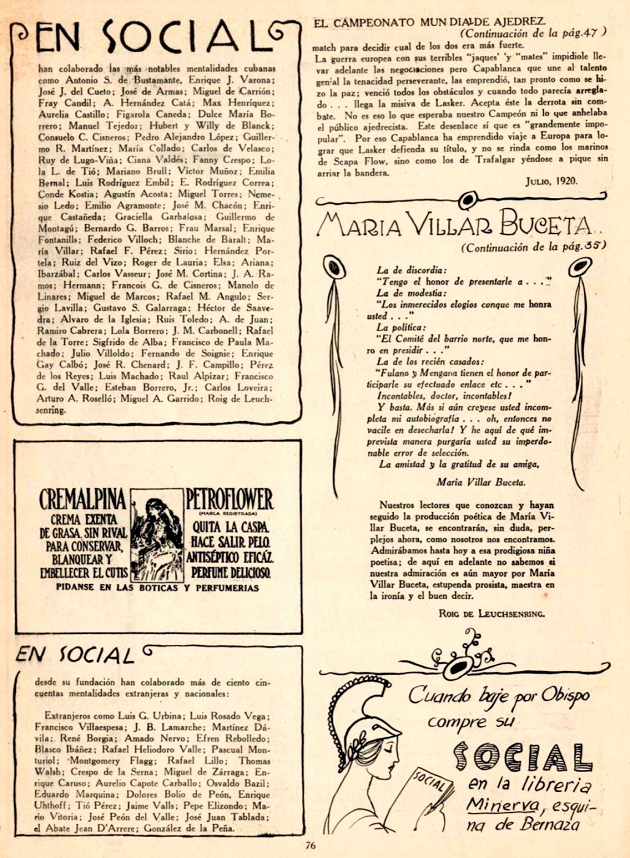
11369. Photographs from La Nación
Among the masters shown below are Alechón (Poland), Marshall (England) and Richa Retti, as well as Capablanca playing living chess against the German champion Blalner.
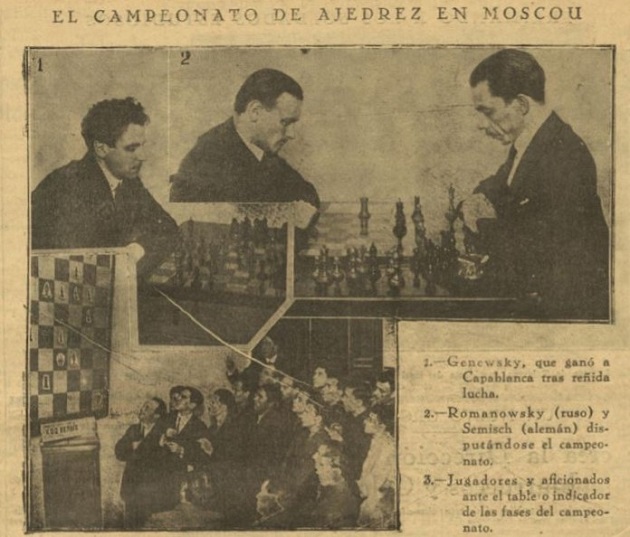
La Nación, 17 December 1925, page 3
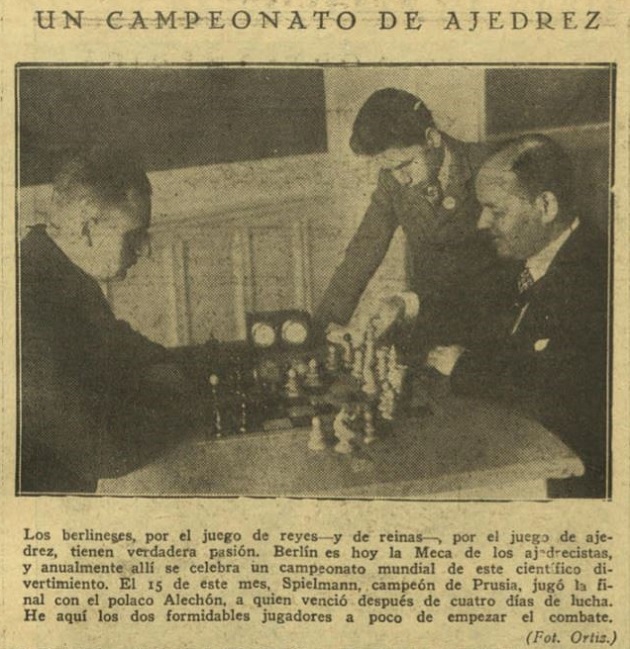
La Nación, 22 April 1926, page 3

La Nación, 13 October 1926, page 1a

La Nación, 13 October 1926, page 1b

La Nación, 31 March 1927, page 5
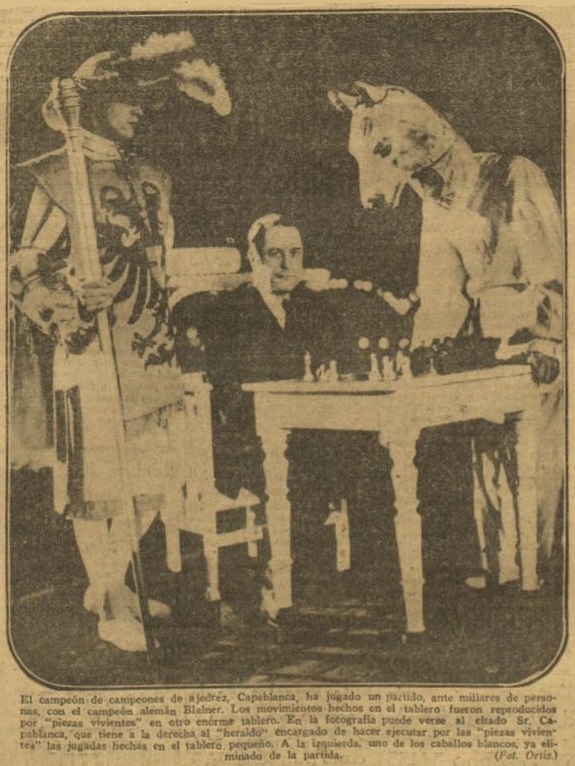
La Nación, 1 August 1930, page 1
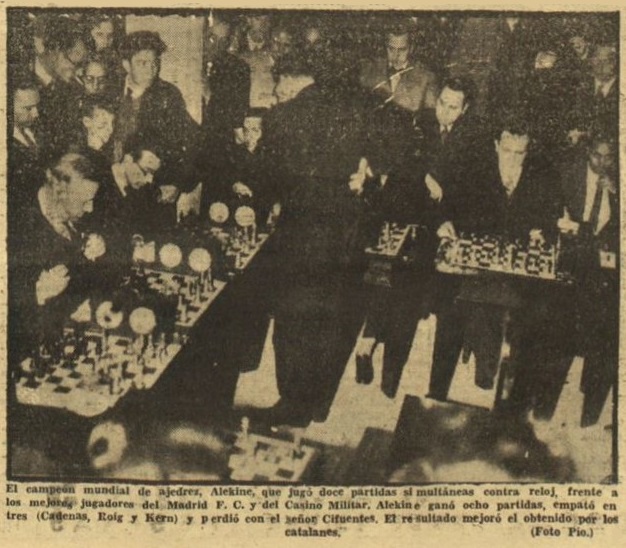
La Nación, 27 February 1935, page 9.
The caption to the Rudolf Spielmann photograph in the Madrid publication is especially bizarre and, in any case, Spielmann was playing against Gilg (see C.N.s 3405 and 4532) and not ‘Alechón’. C.N. 4092 pointed out that Capablanca’s opponent was Elstner, and not ‘Blalner’.
11370. An interview with Curt von Bardeleben (C.N. 10257)
Concerning the interview with C. von Bardeleben on page 129 of The Sketch, 14 August 1895 (C.N. 10257), Colin Patterson (Cullercoats, England) notes that, contrary to the statement attributed to the master, he did not win first prize at Frankfurt, 1887 but finished fourth:
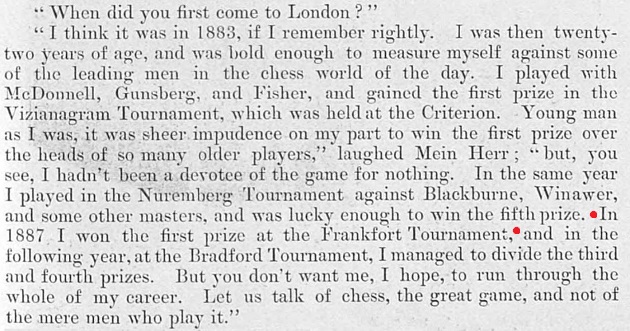
Von Bardeleben’s fourth prize – he had been in the lead after the first week of play – is confirmed by the tournament book, which he co-edited with Hermann von Gottschall and Jacques Mieses. In addition to the full crosstable on page 13, this summary was on page 12:
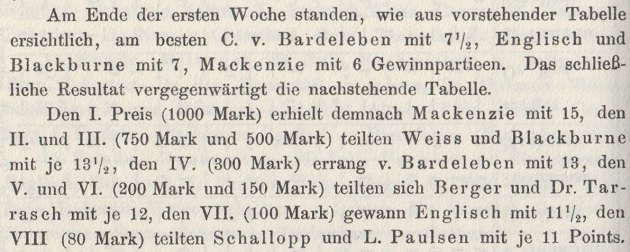
11371. Caricatures
A set of caricatures from page 11 of Destino (Barcelona), 25 January 1964:



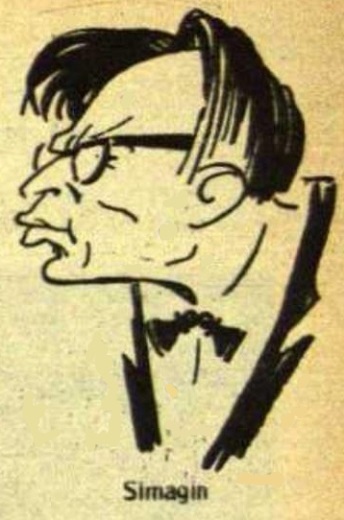
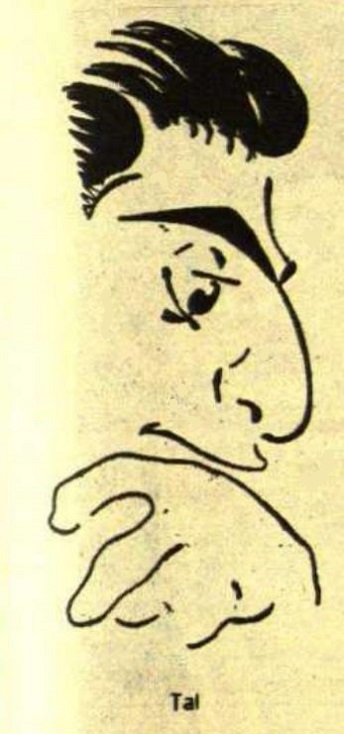
Gligorić, Hort, Keres, Simagin and Tal all participated in a tournament in Moscow in late 1963.
11372. Mutilated game-score (C.N.s 4075, 4084 & 4093)
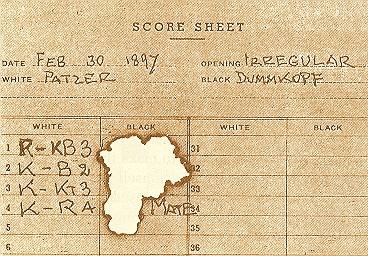
As mentioned in C.N. 4093, this score-sheet was given on pages 347-348 of The Colossal Book of Short Puzzles and Problems by Martin Gardner (New York, 2006), the task being to reconstruct the game.
Now we add, firstly, Leonard Barden’s chess column on page 13 of the Guardian, 24 December 1971:
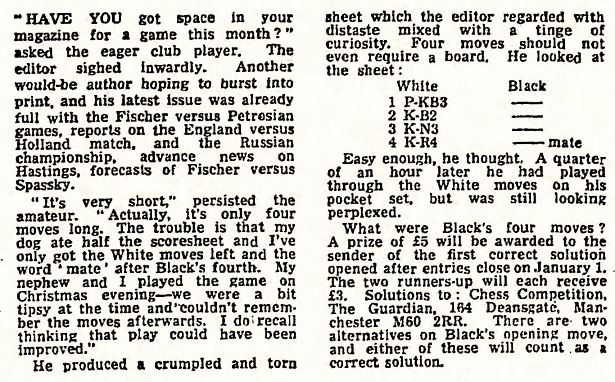
The solution was on page 15 of the Guardian, 10 January 1972:
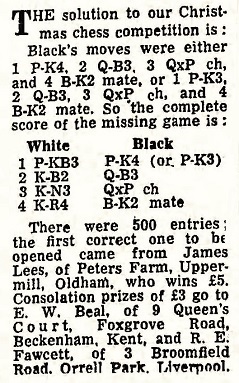
Leonard Barden, who has given us permission to show the two cuttings, does not recall his source for the puzzle, which was not his own invention. As mentioned in C.N. 4093, Randolph W. Banner, the contributor of the puzzle to Martin Gardner’s book, could say only that he ‘thinks he saw it in an English periodical published about 1920’.
Page 377 of The Complete Idiot’s Guide to Chess by Patrick Wolff (New York, 2005) ascribed the puzzle to Sam Loyd, but is that correct? The earliest publication that we can currently cite, with no composer stipulated, is page 53 of the Cincinnati Enquirer, 1 April 1934. However, see also pages 103 and 106 of Odesskie tayny Aleksandra Alekhina by Sergei Tkachenko (Moscow, 2016/17) and pages 89 and 92 of the 2018 English edition, Alekhine’s Odessa Secrets.
Chess Puzzles includes an adaptation that we concocted (C.N. 4075):
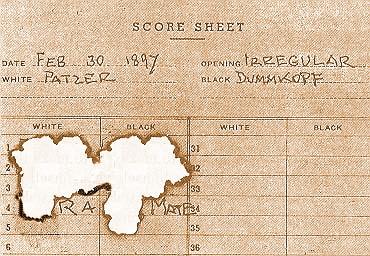
‘The Patzer, who moved
only one pawn, was so mortified by his quick defeat
that he burned the score-sheet. Did he burn it enough to
disguise how he was mated?’
11373. Alekhine’s death
Concerning Alekhine’s death, Roberto Roig (Lima) draws attention to a report on page 29 of ABC, 26 March 1946.
11374. Zurich, 1934

The group photograph is on page 49 of the tournament book:
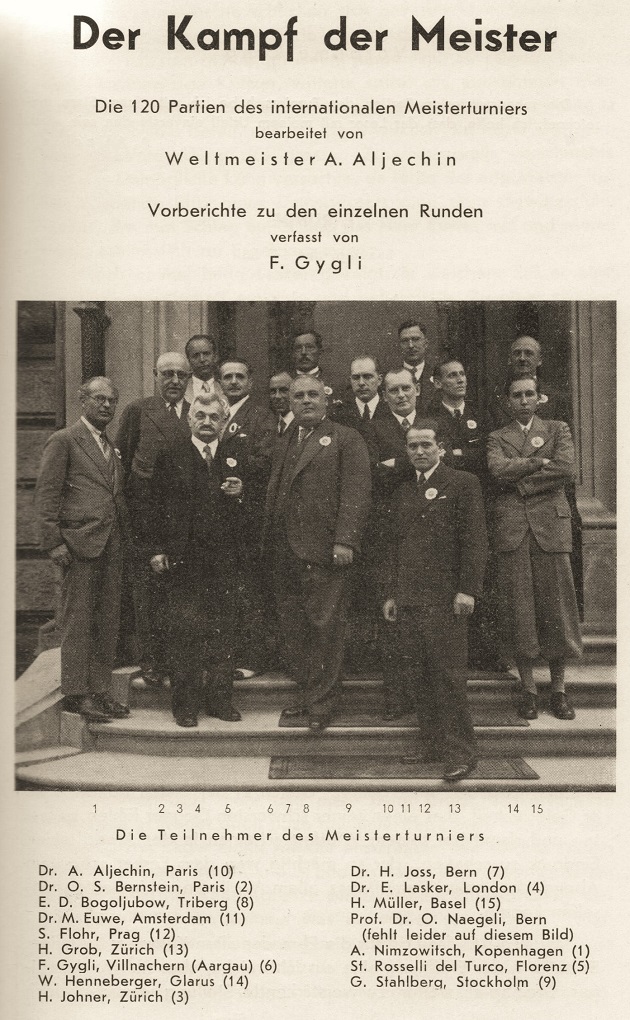
Another shot is given below courtesy of Richard Forster (Zurich). It is on page 347 of his book Schachgesellschaft Zürich 1809 bis 2009 (Zurich, 2009).
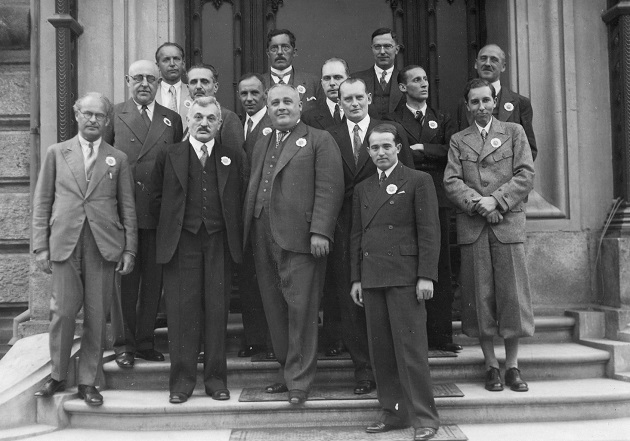
A third group photograph, which includes the Turnierpräsident Fritz Widmann, is owned by Silvio Ziger (Prague), who, via Richard Forster, has authorized its reproduction here:
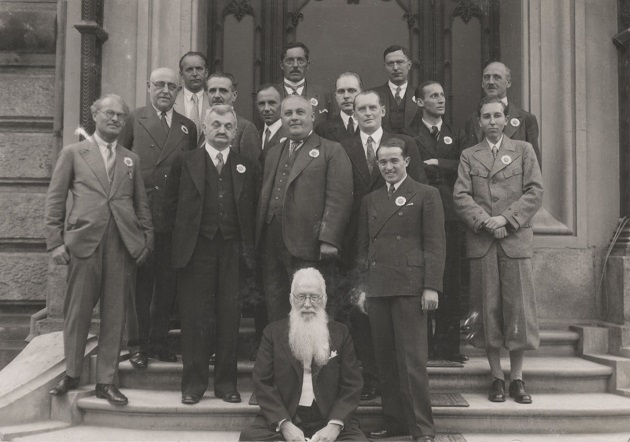
11375. Mate with an en passant capture
Regarding the shortest possible game ending with mate through an en passant capture, a topic raised in C.N. 179, Michael McDowell (Newtownards, Northern Ireland) gave the following in C.N. 221: 1 b3 h6 2 Bb2 f5 3 e4 Kf7 4 exf5 Qe8 5 Qg4 g5 6 fxg6 mate.
That was in 1982. From Larry Evans’ reply to a reader on page 20 of the April 1993 Chess Life:

In C.N. 254 (late 1982) Philipp Mottet (Zuchwil, Switzerland) submitted 1 e4 e5 2 Qh5 d6 3 g4 Nc6 4 Bh3 Kd7 5 g5+ f5 6 gxf6 mate. However, the task of constructing the shortest game with discovered mate by means of an en passant capture had already been resolved by Pal Benko.
Page 31 of the March 1982 Chess Life:
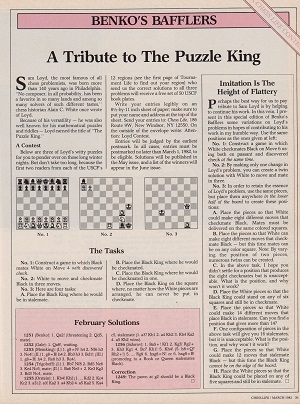
Discussing Sam Loyd, Benko offered this addition:
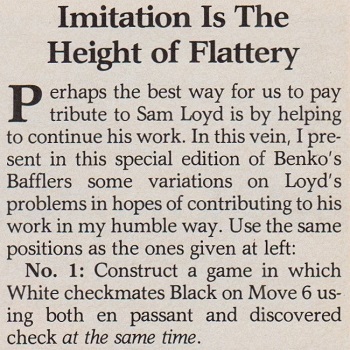
The solution was on page 46 of the April 1982 Chess Life: 1 e4 e5 2 Qh5 Nc6 3 g4 d6 4 Bh3 Kd7 5 g5+ f5 6 gxf6 mate.
From page 654 of Pal Benko My Life, Games and Compositions by P. Benko and J. Silman (Los Angeles, 2003):
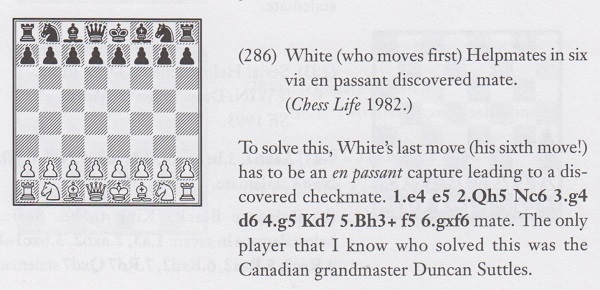
A number of webpages give the source of Benko’s composed game as ‘Chess Life & Review, 1976’, as did page 30 of Chess Braintwisters by Burt Hochberg (New York, 1999). However, C.N. 333 pointed out that the puzzle had been shown by Leonard Barden in a Christmas quiz on page 11 of the Guardian, 24 December 1975. (Page 14 of the 12 January 1976 edition announced that the first correct entry opened was from John Littlewood.)
The earliest appearance of the Benko puzzle that we can cite is on page 675 of the October 1975 Chess Life & Review, in an article by Hochberg:
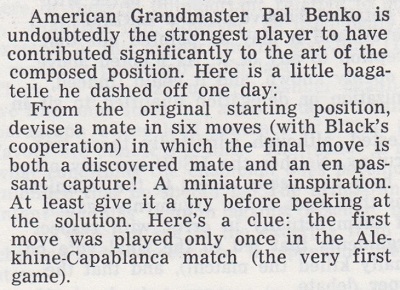
The solution (printed upside-down on the same page):

11376. Grünfeld v Alekhine, Carlsbad, 1923
From page 224 of Combinations The Heart of Chess by Irving Chernev (New York, 1960):
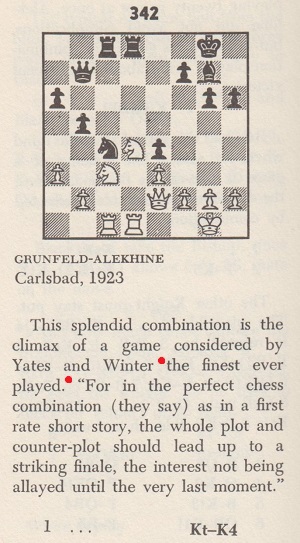
A more extensive quote attributed to F.D. Yates and W. Winter had been given by Chernev on the inside front cover of Chess Review, February 1954:

Similarly, from page 268 of Chernev’s The Golden Dozen (Oxford, 1976):
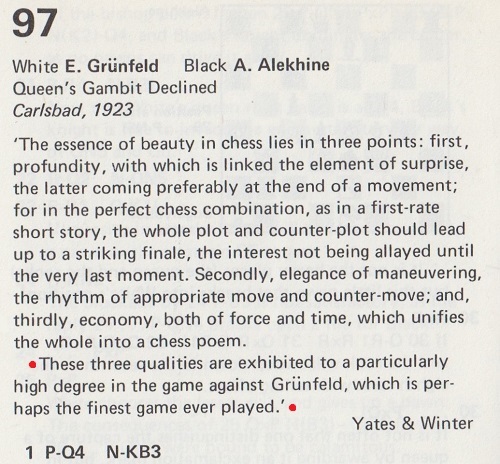
The discrepancy between ‘the finest’ and ‘perhaps the finest’ prompts verification of what F.D. Yates and W. Winter actually wrote.
In their book Modern Master-Play (London, 1929) the bulk of the text quoted by Chernev appeared on page 17, in the Alekhine section:
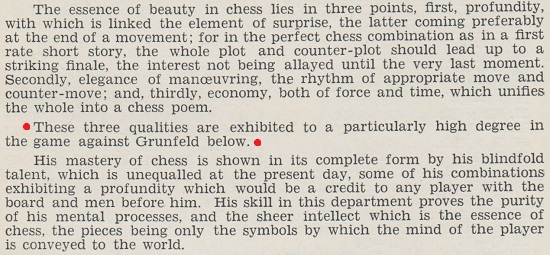
However, there is no ‘perhaps the finest game’ reference. Nor do such words occur on pages 18-19, where the game was annotated:
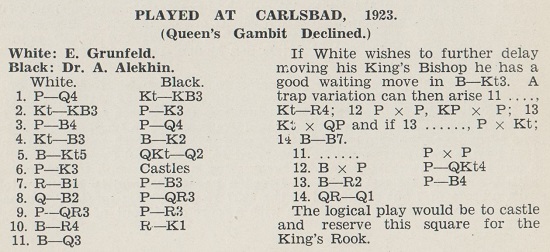
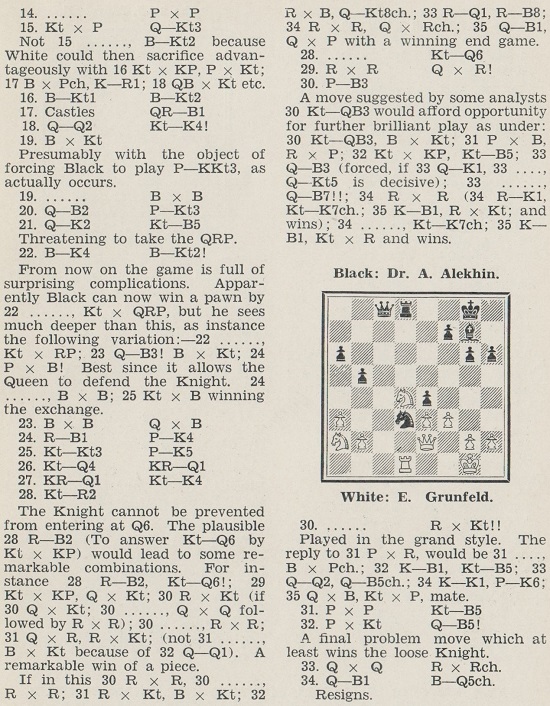
It is necessary to turn to page 6, in the Foreword, where
the book’s publisher, W.H. Watts, gave the words
second-hand:

11377. Moscow, 1925
Another feature from Social (February 1926, page 35) has been provided by Yandy Rojas Barrios (Cárdenas, Cuba):

11378. An alleged Mieses v Post position
An extract from page 479 of the November 1987 BCM, in an article by Jim Walsh about resignation in a winning position:

There is strikingly similar material, including the attribution ‘Mieses-Post, Mannheim, 1914’ and the vague Szabó/1950 reference, on page 110 of Endgame Tactics by G.C. van Perlo (Alkmaar, 2006).
Walsh’s article gave rise to three items in the magazine’s Quotes & Queries column, conducted by K. Whyld:

January 1988, page 26
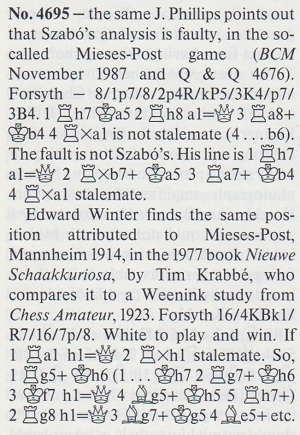
March 1988, page 128

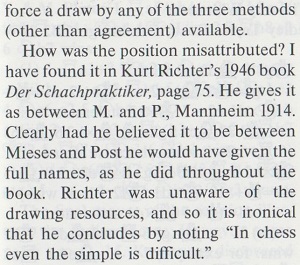
April 1988, pages 170-171
Below is the position referred to in Quotes & Queries item 4701, from page 81 of Schachjahrbuch für 1914. II. Teil by Ludwig Bachmann (Ansbach, 1914):

See too pages 24-25 of Practical Endgame Tips by Edmar Mednis (London, 1997), which stated that after 1 Rh7 the drawing line 1...a1(Q) ‘was recently discovered by the readers of my column in Europe Echecs’ but had also been pointed out by Szabó.
Documentary evidence about Szabó’s exact involvement is sought. Above all, when were Mieses and Post’s names first attached to the ending?
11379. Havana, 1966
From the Keystone Pictures archives Olimpiu G. Urcan (Singapore) has obtained permission for us to reproduce two photographs of Fidel Castro:
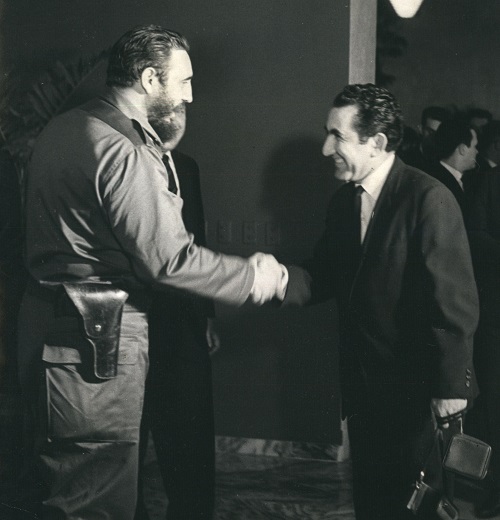
With Tigran Petrosian
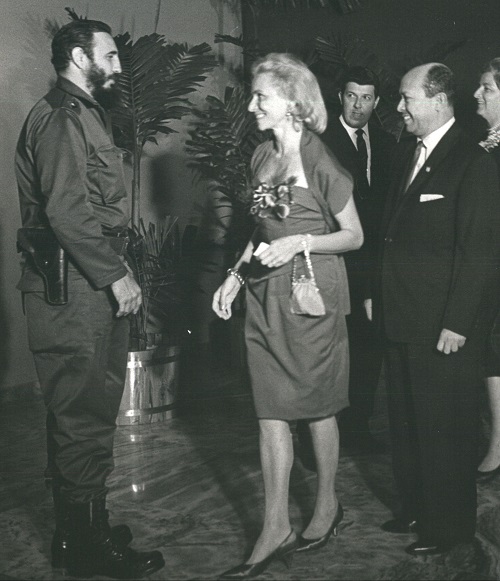
With Ella Johansson (the wife of Folke Rogard) and José Luis Barreras
11380. Quotes
An excerpt from page 52 of The Chess Scene by David Levy and Stewart Reuben (London, 1974):
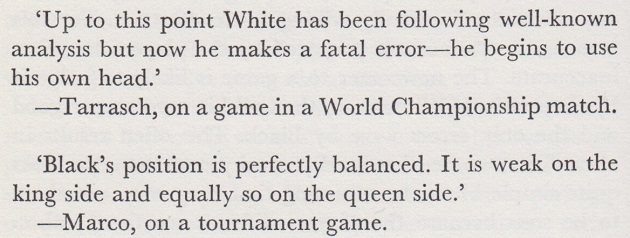
Information about those sourceless quotes was requested in C.N.s 5499 and 5248 respectively, and Michael Lorenz (Vienna) now points out that the latter observation is not by Marco but by Tarrasch:
‘Schwarz hat eine sehr symmetrische Stellung aufgebaut: er steht auf dem Damenflügel gerade so schlecht wie auf dem Königsflügel.’
Tarrasch made the remark after Black’s ninth move in Janowsky v Delmar, Cambridge Springs, 1904. His annotations from the Berliner Lokalanzeiger were reproduced on pages 316-317 of the October-November 1904 Wiener Schachzeitung (edited by Marco).

Position after 9...Nd7
11381. Anderssen v Kieseritzky
There is no consensus over the exact concluding moves of the Immortal Game. On pages 221-222 of La Régence, July 1851 Kieseritzky himself stated that the finish was 19 e5 Qxa1+ 20 Ke2:
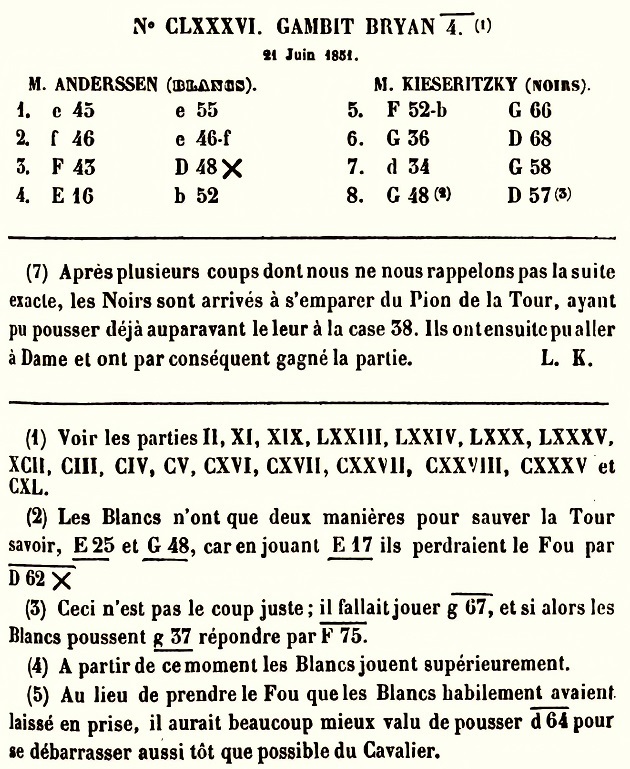
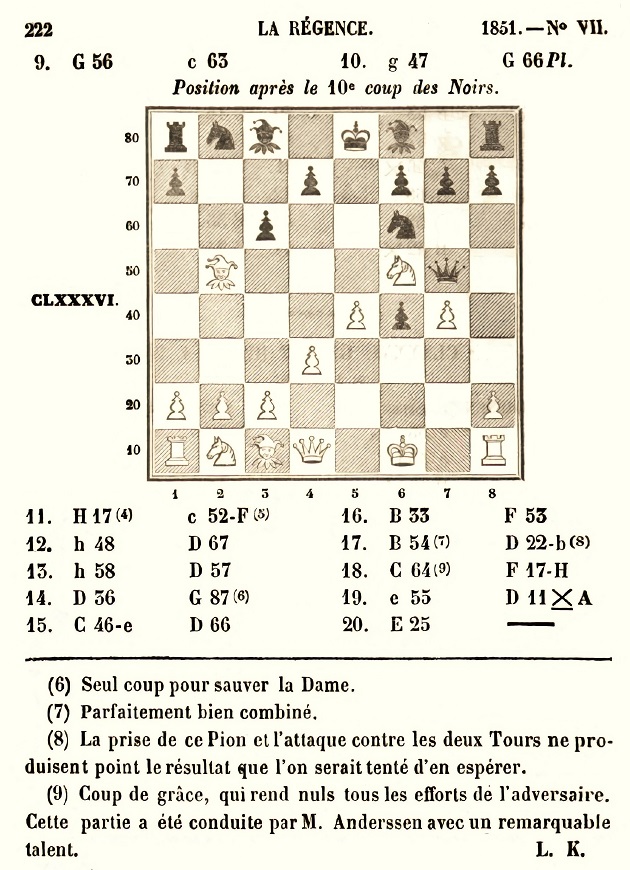
Note 7 on page 221 relates to a previous game in the magazine.
11382. Mate with an en passant capture (C.N. 11375)
Michael McDowell (Westcliff-on-sea, England) notes that his invented game concluding with an en passant capture (C.N. 221) was anticipated by C.D. Locock according to page 6 of Synthetic Games by G.P. Jelliss (1998). However, the Locock game appeared not in the January 1921 Chess Amateur (‘CDL CA i 1921’) but on page 152 of the February 1922 Chess Amateur, in T.R. Dawson’s ‘Fairy Chess’ column.
11383. Tournaments in Gijón
Our latest acquisition is The Gijón International Chess Tournaments, 1944–1965 by Pedro Méndez Castedo and Luis Méndez Castedo (Jefferson, 2019).
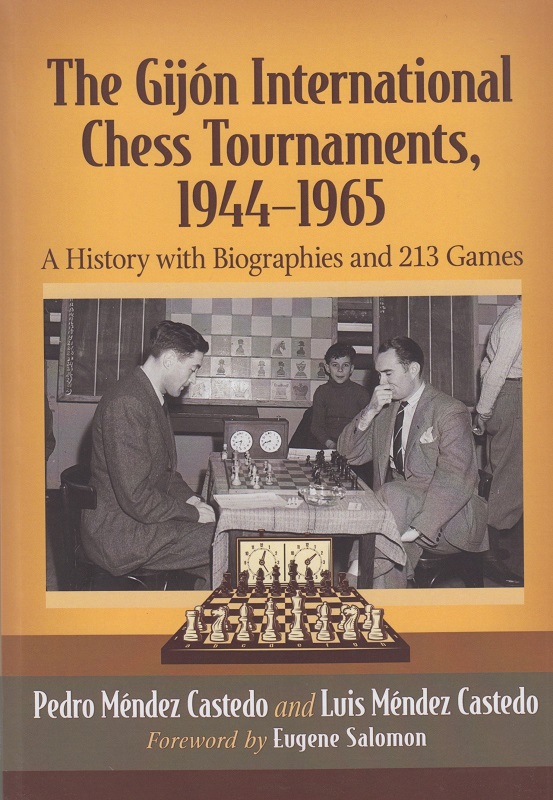
11384. Erling Tholfsen and Leo Edward (C.N. 11362)
Another game between the same players, also with a queen sacrifice, has been found by Eduardo Bauzá Mercére (New York, NY, USA) on page 22 of the Brooklyn Daily Eagle, 27 April 1933, preceded by a win by Tholfsen against Robert Willman:

Our correspondent notes that both games were also on page 68 of the April 1933 American Chess Bulletin.
Tholfsen v Willman: 1 d4 Nf6 2 Nf3 e6 3 c4 d5 4 Nc3 Nbd7 5 Bg5 c6 6 cxd5 exd5 7 e3 Bd6 8 Bd3 O-O 9 O-O Re8 10 Re1 Be7 11 Qc2 Nf8 12 a3 Ne4 13 Bxe7 Qxe7 14 Bxe4 dxe4 15 Nd2 f5 16 d5 c5 17 Nc4 b6 18 Nb5 Rd8 19 Red1 Ng6 20 g3 Bb7 21 d6 Qf6 22 Qc3 Qxc3 23 bxc3 Rd7 24 a4 Bc6 25 h4 Bxb5 26 axb5 Re8 27 Rd5 Kf7 28 h5 Ne7 29 Re5 Nc8 30 Rxf5+ Ke6 31 Re5+ Kf7 32 Rd5 Red8 33 Rad1 Ke6 34 Re5+ Kf6 35 Red5 Ke6 36 Re5+ Kf6 37 Rdd5 Nxd6 38 Nxd6 Rxd6 39 Rxd6+ Rxd6 40 Rxe4 Rd5 41 Rf4+ Resigns.
Edward v Tholfsen: 1 Nf3 Nf6 2 d4 g6 3 c4 Bg7 4 Nc3 O-O 5 e4 d6 6 Be2 Nbd7 7 h3 e5 8 Be3 Qe7 9 d5 a5 10 a3 Nc5 11 Qc2 Bd7 12 Rd1 a4 13 Bxc5 dxc5 14 g4 Ne8 15 Bd3 Nd6 16 g5 f6 17 h4 f5 18 Qe2 Rf7 19 exf5 gxf5 20 Nd2 e4 21 Bc2 Bd4 22 Nf1 Re8 23 Nxa4
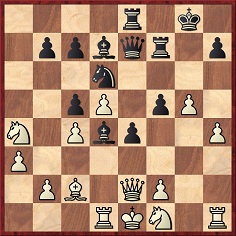
23...f4 24 Nc3 f3 25 Qd2 Nxc4 26 Qc1 e3 27 Rxd4 exf2+ 28 Kxf2 Qe2+ 29 Nxe2 Rxe2+ 30 Kg3 Rg2 mate.
11385. Smyslov’s first chess book
David Prabitz (Graz, Austria) notes Vassily Smyslov’s slightly different accounts (i.e. with ‘father’ and ‘uncle’) of the first chess book that he was given as a child. Below are the Russian and English texts in three autobiographical works:

Избранные партии (Moscow, 1952), page 16

My Best Games of Chess 1935-1957 (London, 1958), page xxxiii
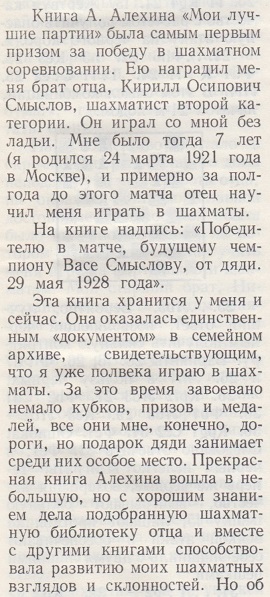
В поисках гармонии (Moscow, 1979), page 5

125 Selected Games (Oxford, 1983), page 1
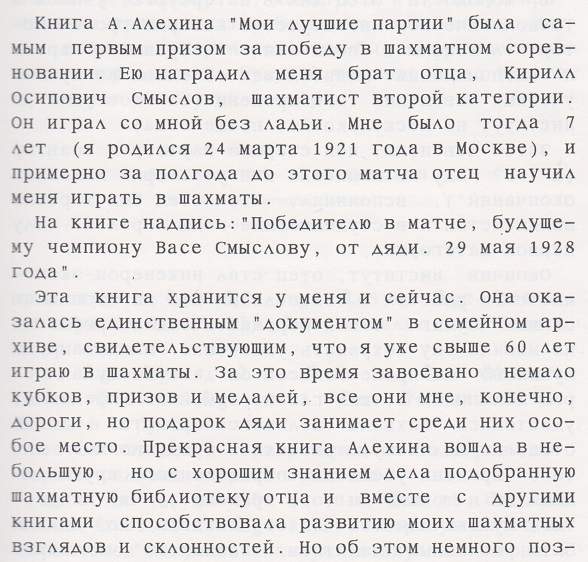
Летопись шахматного творчества (Moscow, 1993), page 7

Smyslov’s Best Games, volume one (Olomouc, 2003), page 5.
The first English translation was by P.H. Clarke, and the other two were by Kenneth P. Neat.
The Russian translation of Alekhine’s first Best Games volume was published in 1927, mentioning a print-run of 5,000 copies. The second edition (1928) stated that 7,000 copies were printed.
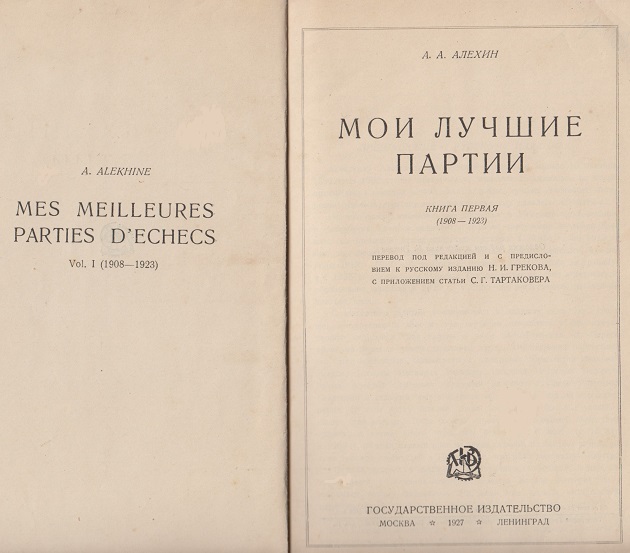
Notwithstanding the text opposite the title page, Alekhine’s book did not appear in French until 1936 and was not entitled Mes meilleures parties d’échecs. See C.N.s 4436 and 4439.
11386. Nimzowitsch v Ståhlberg match
From page 26 of the February 1934 Tidskrift för Schack:

The scan has been provided by the Cleveland Public Library.
A small publication on the match (11 pages) was produced by Dale Brandreth (Caissa Editions, Yorklyn) in 1979, with the masters’ notes translated by Ole Hellsten from Danish and Swedish.
11387. Salo Flohr (C.N.s 6319 & 6327)
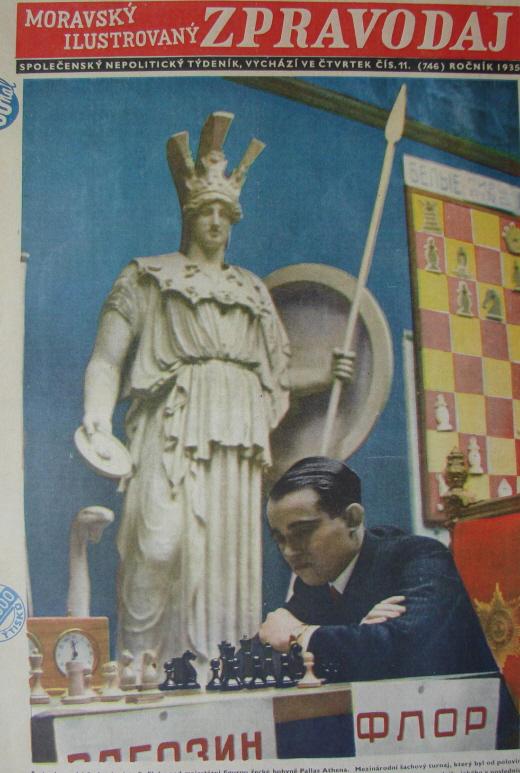
A monochrome version of this photograph of Flohr in play against Ragozin at Moscow, 1935 occupied most of page 57 of the March 1935 Tidskrift för Schack.
11388. Golombek v Fazekas
Page 18 of CHESS, October 1953 gave Golombek’s win against Fazekas in round ten of the British Championship in Hastings, August 1953: 1 Nf3 Nf6 2 d4 g6 3 c4 Bg7 4 Nc3 O-O 5 e4 d6 6 Be2 Nfd7 7 O-O e5 8 Bg5 f6 9 Be3 Nc6 10 Qd2 g5 11 dxe5 Ndxe5 12 Nxe5 Nxe5 13 f4 Nf7 14 Rad1 h6 15 Qc2 Be6 16 c5 Qe7 17 f5 Bd7 18 Nd5 Qd8 19 b4 Re8 20 Bd4 c6 21 Nc3 dxc5 22 Bxc5 Bf8 23 Qb3 Bxc5+ 24 bxc5 Qc7 25 Bh5 Bc8 26 Rd6 Kg7 27 Rfd1 Re7 28 Bxf7 Rxf7 29 Ne2 Qe7 30 Qf3 Qe5 31 Rd8 Rf8 32 Qh5 Qxc5+ 33 Kh1 Bxf5 34 R1d7+ Kg8 35 Qxh6 Bxd7 36 Rxd7 Rf7 37 Qg6+ Kh8 38 Qxf7 Resigns.
As reported on page 26 of the November 1953 issue, several readers (E.R. Gordon of Stogursey being the first) pointed out that Golombek missed a mate in two towards the end. It was not mentioned whether he was in time-trouble.
| First column | << previous | Archives [179] | next >> | Current column |
Copyright: Edward Winter. All rights reserved.